#only the st soundtrack version does...
Explore tagged Tumblr posts
Text
When you see it...

#byler#stranger things#birthdaygate#st music#the original and remastered do not have a 3:22 running time#only the st soundtrack version does...#some versions of the st soundtrack version show 3:21 but most show 3:22 when actually clicked on#not to mention#the st version holds off bringing in the music until like 9 seconds in#so there’s a lot of lost time…#if anything it should be longer#but isn't that ironic#given that this song plays the same moment the screen shows us the date 3.21#the day before 3.22#yeah...
75 notes
·
View notes
Note
happy sts !
i saw on your intro post of A Spark of Magic that you do playlists for your wips. i'd love it if you shared some of them and if you told us your thoughts about crafting them :]
writblr: @vsnotresponding
Hello! Happy STS to you too ☺️
Thank you so much for your question! I love music (I'm always listening to it), so I try to create a playlist for my WIPs as soon as I start working on them. My playlists tend to be messy because they're a collection of songs that help me brainstorm the story, remind me of a certain character, or would be part of a specific scene I want to write/have already written.
My playlists, much like my manuscripts, also have several drafts/versions. The first one tends to be an eclectic collection of all the songs that remind me of said WIP, but as I finalise the manuscript and finish its structural edits, I usually remove songs until only the "official soundtrack" remains.
How I choose which song fits and which song depends on whether it makes sense sonically with the tone of the story and whether or not it relates to a scene or character.
I'll share more details about the playlist of A Spark of Magic below but I didn't go more in-depth with other WIPs because I'd make this super long, but I've linked them too in case you want to check them out/listen to them!
✨ A Spark of Magic
A Spark of Magic has some mysterious vibes and magic, but since its main characters are teenagers and it's set in our world (in a small town located near the mountains), I wanted the playlist to reflect that atmosphere and vibe.
The first playlist I created for this WIP had about 26 songs. You can find it here, and you'll notice I've renamed it to A Spark of Magic Series because this is where I'll add all the songs that will inspire/influence this series.
The final version, and the one I've included in the book (I include playlists in my books), only has 10 songs. These songs are organised chronologically so they either match events of the book and/or an inner struggle of the character, kind of like a soundtrack. You can listen to this final version here, and you'll see it's much shorter but also more cohesive sonically (I think).
🍰 Not Another Cinderella Story
As the placeholder name suggests, this WIP is a Cinderella retelling, but this one is set in modern times and in a fictional European country named Tudal. I wanted this playlist to have some sweet vibes (with its fair share of heartache), so I've included some songs that have fairy tale vibes. Those include Bewitched by Laufey, Enchanted (Taylor's version) by Taylor Swift, and Slow Burn by Kacey Musgraves.
You can listen to the full playlist here but this isn't organised properly yet so it's a big mess!
🏙️ Risky Business
This is the playlist I created for my adult contemporary serial, and I'm mostly sharing it because it's currently my longest playlist (it has 213 songs). This serial takes place in a cosmopolitan city and it features six different points of view, so it has an even bigger collection of songs that reflect all their storylines and moments. You can listen to it here, but as I said, it's very long (and messy).
I have many other playlists for my never-ending WIPs, but hopefully, this gives you an idea of how music influences my process!
What about you, does music have any influence on your writing process?
I wish you a lovely day/night!
#tari answers#storyteller saturday#✨: playlist#book: a spark of magic#w: not another cinderella story#w: risky business
7 notes
·
View notes
Text
Play South Park (USA) On My Emulator Online

Hi this is Steven Moore no way children and the kids cannot play the game called South Park in 1998 that's why the computer game called South Park is Rated M because that's why the computer game called South Park it does have a lot of violence in it and it does have a lots of blood and gore in it and it does have poop in the streets that's why the computer game called South Park is Rated M it's only for Nintendo 64 that's why young children cannot play the game called South Park because that's why the computer game called South Park it does have a lots of violence it does have a lot of blood and gore in it and they poop in the streets with chickens that's why the computer game called South Park is Rated M it's only for Nintendo 64 from Steven Moore
#becky g#hailee steinfeld#annie leblanc#brighton sharbino#dafne keen#anllela sagra#lizzy greene#zuzka light#piper rockelle#coco quinn#maya le clark#kristina pimenova#kristina peric#kylie cantrall#sabrina carpenter#sky katz#Spotify#SoundCloud
2 notes
·
View notes
Text
Star Wars: Shadows of the Empire
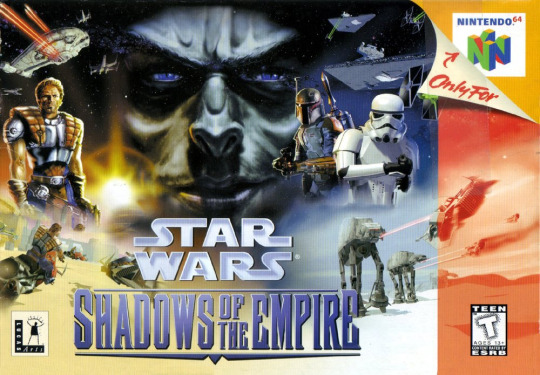
NA release: 3rd December 1996
PAL release: 1st March 1997
JP release: 14th June 1997
Developer: LucasArts
Publisher: Nintendo
N64 Magazine Score: 78%

Shadows of the Empire was a big “Expanded Universe” multimedia event with this story getting a novel, soundtrack (for the novel), comic book, toys and, of course, a video game. Shadows of the Empire was released on the N64 on PC. I was originally going to use the PC version for this, as the game is identical, but it has video cutscenes with voice acting, but controller support is poor (and the HUD goes tiny). With the help of remapping buttons, I was able to create a good setup that uses modern using the strafe setup.
I played this as a kid and I do remember enjoying it.

The game starts off during the Battle of Hoth from The Empire Strikes back, with you controlling a snowspeeder. This section is great, with the snowspeeder feeling great to control and toppling AT-ATs with the tow cable is great. Unfortunately, the level isn’t very long and it’s the best part of the game (you may notice the large amount of lives – that’s more for the poor platforming in later stages). If the entire game was like this, it would be a great game, but most of the game is on-foot.

You play as Dash Randar, who in this game is essentially a Han Solo clone (the novel expands the character’s personality a lot). You’re armed with a blaster that recharges, and you can get special ammo for it (best saved for bosses). The game heavily relies on autoaim, which is especially necessary as you can’t really aim up or down in any reasonable way (the aim button lets you, but it’s far too sensitive).
Trying to setup so you can flee Hoth, you start by watching the Millenium Falcon leave (shouldn’t Vader be standing nearby?) then blast your way through the stormtroopers attacking the rebel base. The shooting isn’t very satisfying and the movement is wonky.
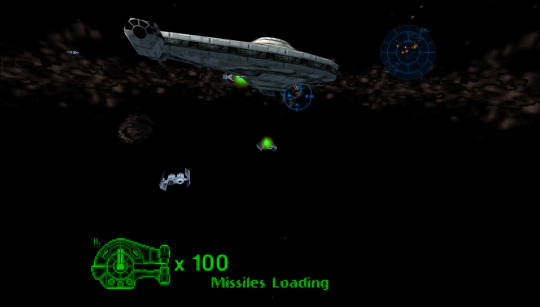
After blowing up an AT-ST, you make your way off Hoth and blast TIE fighters in an asteroid field in a dreadful turret section with awful controls. The game at least gives you plenty of time to react as the bombs from the TIE bombers are really slow, and you have infinite missiles – they just reload between batches of 5.

Hunting for Boba Fett, Dash heads to a junkyard planet to get information from IG-88. I absolutely hate this level as a kid due to the controls but I didn’t find it too bad – I think the ability to strafe helps a lot with lining up jumps, and I never figured that out the first time round. It’s still a very ugly planet, though – Shadows of the Empire was definitely ahead of its time for its use of greys and browns. At the end of the level you take out IG-88, who gives you information on where Boba Fett is.
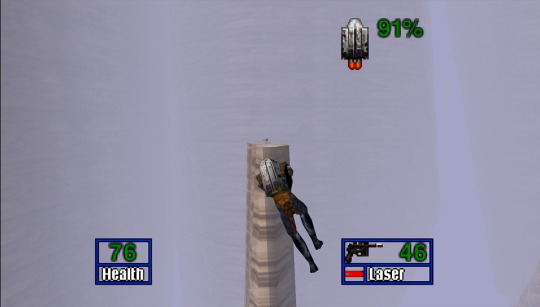
This is where the platforming really does take a nosedive. Dash’s jump is incredibly floaty and not difficult to control, and the narrow paths of this level are built for you to fall off constantly. You get a jetpack half way through which helps a bit, but is not as fun as a jetpack should be due to being slow and only possible to use for short bursts.
You fight Boba Fett and the Slave 1 at the end. I ran out of ammo, but found a spot where Slave 1 couldn’t hit me, so was able to hit it a few hundred times to destroy it.
Some text explains that after this, Boba Fett escapes and an assassin tries to kill Luke, so it’s up to you to help protect him.

As Luke chills out at Obi-Wan’s home on Tatooine, Dash hears of a swoop gang heading to kill Luke. Speeding through this level is great, but it’s much better to go slowly to take out enemies. You find out information that an Imperial ship contains the necessary information.
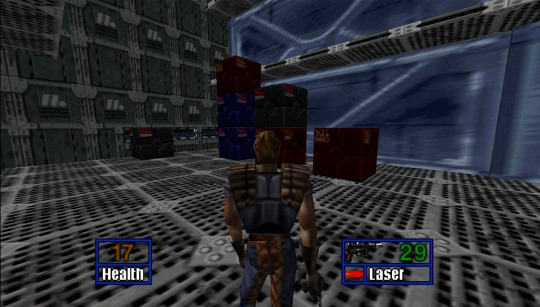
As Luke waits outside in his X-Wing, Dash assaults the imperial ship on his own (this game makes Luke seem weak). Most of this level is messing with door switches in a large cargo hold. There’s some secrets to find, but you need to work your way, then fighting a big droid near the end. The jetpack you found earlier would have been handy, but Dash left it on his ship. On a side note, I do really like the Outrider.

In order to infiltrate a base, we need to go through a sewer. Dash has absolutely no issue diving though massive amounts of excrement as you have to find a few different items to progress. The boss fight at the end is a horrible experience, with respawning tentacles and the poor jetpack controls underwater.
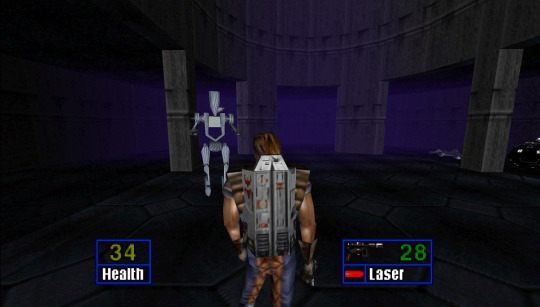
Going through the base your job is to find a reactor to place charges to blow up a space elevator. Luke is also infiltrating this base to save Leia, but that’s just background information and you never get to see them during gameplay. This is another dull level.

After another bad ship turret section, we get to actually fly the Outrider, and it’s great. You don’t get to focus on shooting other ships, though: your mission is to shoot four turrets then fly into the base and blow up the reactor, Death Star 2-style. The game ends with Dash seemingly not making it (but then reveals his fate in the final cutscene).
Shadow of the Empire is not as fun as I remember. The genre has evolved a lot, and the controls are just strange and floaty. The full story is probably good, but this isn’t a good adaptation as important points are relegated to scrolling text.
The first and last levels are superb. Some of the rest are good. A sad few are awful.
- James Ashton, N64 Magazine #1
Remake or Remaster?
This game definitely needs a remake, perhaps with a few more levels added as well, with better integration of the story – perhaps even working alongside Luke.
Official ways to get the game.
The PC version of the game is available via GOG and Steam
#n64#n64 games#nintendo 64#nintendo#retro games#gaming#star wars#star wars games#shadows of the empire#star wars extended universe
3 notes
·
View notes
Text
HOLLY BOWLING, THE ATOMIC PAVILION, 1 JUNE 2025
HOLLY BOWLING spectacularly came to wide attention 10 years ago as part of the run up to the Fare Thee Well shows that marked the last time Mickey Hart, Billy Kreutzmann, Phil Lesh would play together. She contributed a solo piano version of the Louisville 7/18/74 Eyes of the World, the whole band portrayed with her ten fingers. During Lockdown, her Wilderness Sessions took her, a keyboard, some effects, a van, a drone, and cameras to spectacular locations where she unfolded sets of Grateful Dead and Phish tunes weaving in and out of one another. But she also does playing in the band and was a treasure everytime she participated last summer in Professor Lesh’s final seminar in the Terrapin Clubhouse/Darkstarathon videos. She listened sympathetically and helped drive jams in a way not seen in this music since Bruce Hornsby who nonetheless had the presence of Jerry Garcia to incorporate. Bowling much more than held her own with Grahame Lesh, Stu Allen, Daniel Denato, and Lebo.
But we got a chance to see her in her element in a rather cozy outside show at THE ATOMIC PAVILION under 2.5 miles from my house. A Yamaha grand piano, some looping and echo effects, and some devices for getting at the strings inside the piano to resonate. But the instrument itself played that hard has overtones galore to ring into the night. That’s not to say that there wasn’t also spaces for the music to breathe and moments of subtle delicacy, simply that the majesty of tunes heard through state of the art sound systems starting with the Wall of Sound came from that piano with only occasional alterations.
I wish I knew the Phish tunes that were in conversation with the Grateful Dead music I know so well. I couldn’t tell what was a jam and what was Phish music. That is, for example, The Wheel emerged after several minutes to open, but was there a full blown other tune before it. Her own The Thief Is Insatiable segued out of that opener. Friend Mike recognized the next tune, Hurt from Nine Inch Nails via Johnny Cash.
And then the fun really began, a jam that began here 20 minutes into the first set with Lost Sailor and ended at the end of the second set with Saint of Circumstance. Not seamless, there was a set break and, again, a full stop after St Stephen and the following tune to open the set break. But she kept returning to themes, opening and closing parentheses. So, The Wheel came back into the end of the first set medley and St Stephen came back with the William Tell Bridge in a big big closing sequence that included Cryptical Envelopment into a deep and very strong The Other One which dissolved into the Stephen>Tell which in turn led to a wonderful and roaring The Eleven (with The Other One, my highlights of the night). Maybe she took us back to The Other One but it might have been something Phish-y before Althea with an interesting vocoder type loop/fx. There was certainly some Phish before the concluding Saint of Circumstance. The encore was not the Dead but energetic and fitting.
I spent some time, particularly when the Phish tunes were on thinking about how this was and was not like Keith Jarrett’s solo piano concerts which were certainly more structured than I wanted to believe with motifs, themes, and even specific tunes and not spontaneous compositions. They appealed to my young ears seeking other kinds of soundtracks to chase after thoughts. I somehow feel compelled to add that beer was the drug (and a depressive at that) and the music was and always has been the thing that alters my mind. Jarrett drew on folk songs and major keys for gospelly vamps and some of the same kinds of overtones rather than what has been called by Ethan Iverson “the real bebop.” Bowling isn’t doing jazz either, but she is drawing on a different repertoire of folk songs that fill the air and letting them ring and resonate..
The crowd was too old and too small with under 150 tickets sold. But that and her practice of going to the merch table after gave it a familiar Focal Point/Jazz St Louis feel. I guess I’m not shy about talking to musicians always leading with thanks. For HOLLY BOWLING it was for those Wilderness Sessions and especially Terrapin Clubhouse. I did ask if Phil Lesh was ill at the time and she said no. He was every bit his age, but still completely alert, wryly funny, trying new things. She spoke movingly and was moved in the moment.
I had bestowed my mantle of Deadhead fandom to Joe Russo’s Almost Dead but now I will also rely on HOLLY BOWLING to keep this repertoire alive.
0 notes
Text
ST Season 2 Wardrobe Analysis
Eleven & Hopper
If you have not read my analyses for season 1, the first one can be found here, but the gist of it is:
El has yet to figure out who she is as a person and spent season 1 trying on the clothes of other people like she was trying on their lives.
Pink and blue are colors used together to show the expected and the "normal," showing up profusely in the Wheeler household and wardrobe.
FLASHBACKS
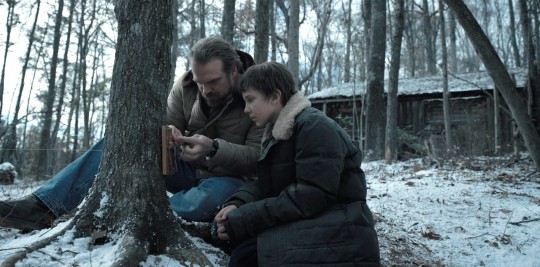
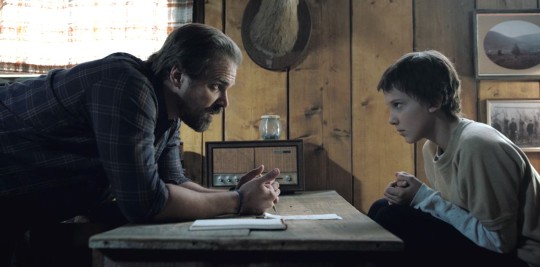
To start off, this flashback from episode 3 presents us with general trends we're going to see for each character. Hopper in a plaid flannel and El with layering. It's also pretty clear that El's wearing whatever she's been given. This being very early on in her stay with Hopper, the clothes have no character at all. They don't even have color. They are absolutely void of personality.

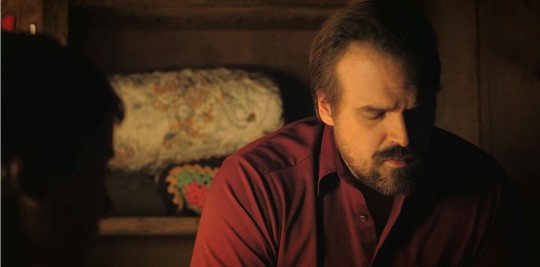
We see El wearing a white thermal in another flashback, something else that will become a trend, so I love seeing its origin here. Hopper's shirt is abnormally plain. He tends to wear plaids, pretty much whenever he's out of uniform. I actually struggled with why he's in solid red, so to help answer that, I hunted for the song playing in the background. And I was disgusted to find that it is "Papa" from the season 1 soundtrack, which plays during this scene:

I hate that. It does sound like a slightly different version of the track with a little less distortion, but this is supposed to be about clothes. So El is experiencing this flashback after finding out her mother is alive and in the scene, Hopper is telling El her mother is "gone." I don't think Hopper's dishonesty (that isn't even technically a lie) and Brenner's horrific behavior in the above scene can be even remotely compared, but El is feeling lonely and sorrowful in both sequences and is being offered the wrong kind of comfort by a father figure. So coming back around to the red shirt, this is the first "red flag" in their relationship. It's the moment Hopper chooses not to be honest, and a lot of the struggle between them later stems from this. And this red flag imagery isn't only in the shirt. It's the lighting.
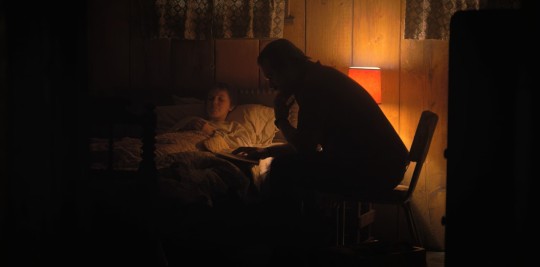
EPISODE 1

On to the present day. I'm going to come back to El's look here later, so I'm not going to say much now, just that this outfit is once again lacking color or prints.
EPISODE 2
I'm getting sidetracked again, but I just want to shout out the cinematography for a second. Utilizing the same camera placement really emphasizes the mundanity, the feeling of doing the same thing over and over again with no change (EACH LIFE A FADED LESSER COPY OF THE ONE BEFORE), that El has been feeling. Okay, I was joking with that quote, but I could write a whole analysis about how that's exactly how El was feeling here.
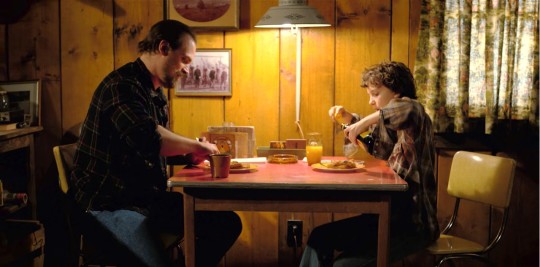
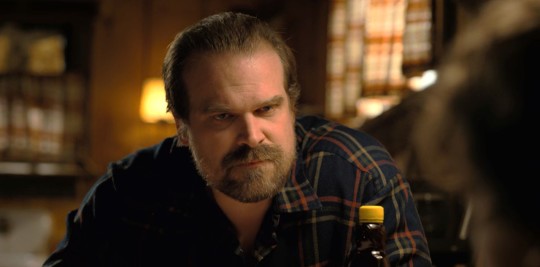
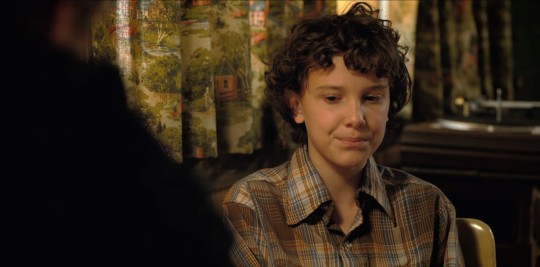
El's finally wearing some color and print, but continuing the pattern from season 1 (dressing like the people around her), she's now dressed just like Hopper. They're both in jeans and flannel in brown, beige, blue, and orange/red. I find the above screenshot of them at the table together interesting because Hopper's navy shirt heavily contrasts him against the walls while El blends in more. The curtains behind her even contain the same shades of orange and blue as her shirt. She appears to be fading (*cough* each day a faded lesser copy) into Hopper's house, which is precisely how she feels. Hopper, on the other hand, matches his home but isn't part of the woodwork.
EPISODE 3

Remember the pink and blue thing I said? This blanket really sticks out in this cabin. El is sleeping with a pink(?) stuffed rabbit(?) as well. There's no way to really know if Hopper bought these things for El or if they were Sara's, so I'll look at it both ways.
They were Sara's: if these were once Sara's belongings, this is yet another example of El trying on other people's lives. In this case, she is trying on the role of Hopper's daughter, but they haven't actually come to an understanding yet, so this still feels like a role she's playing and not a genuine part of her identity.
They're new: if Hopper bought these things for El, this is an indication that he doesn't understand or know her yet. It shows the lack of communication in their current relationship.
Either way, these items feel like dressing. They stick out in the house. Them being in nuclear family coloring shows that Hopper is trying to insert his old understanding of family into this new situation rather than trying to work out something fresh with El.
El is wearing a dainty pastel floral print on her pj thermal, which fits in with the bedding. But then she gets dressed for the day.

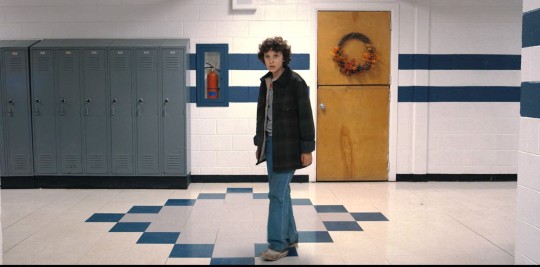
And what I love about this is that she didn't change her clothes. She just put this very boyish t-shirt on top of the floral top (that she slept in). This is a trend we'll see her repeat. She spends the episode adding layers. The thermals, as I mentioned before, are fairly common for her. They feel like a truly EL piece of clothing (and this may be a season 2 analysis, but just think about the last shot of her from season 4: alone, determined, all layers but the thermal shed). But she stacks other things on top of the thermals all the time. The t-shirt and then a plaid jacket (plaid being an element of Hopper) that show that she's covering herself by emulating other people or by bending herself to their expectations or desires.
EPISODE 4
DO YOU SEE WHAT I SEE?????
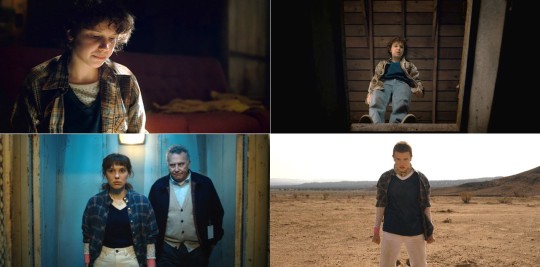
She's wearing a tiny-floral-printed thermal under a blue v-neck under a flannel. In S2E4 El makes the decision to hunt down her mom, setting out on her own, making a huge life-changing decision for herself. Acting with agency and leaving behind her father figure. In S4E3, she makes another huge decision, this time to get her powers back, leaving Mike behind. And in S4E7, she leaves NINA to save her friends against Brenner's advisement, taking agency again and leaving behind a father figure again. And the season 4 outfit resembles this one from season 2 remarkably.
*Side note that this is the same flannel from episode 2
EPISODE 5
El goes to find her mom in episode 5. She is wearing the same outfit she wore in episode 1, plus the flannel from episodes 2 and 4. Plus the jacket from episode 3. What this tells us is that El doesn't have a lot of clothes. Or maybe that El doesn't care about her clothes. Or that El has a few items of clothes she likes a lot and clings to. I think it's likely a combination of all of that. She came from the lab where she never had a variety and never got to choose. I think the way she mixes and matches a few items is her trying different things on a very small scale, but she's also drawing inspiration from the only person around her.
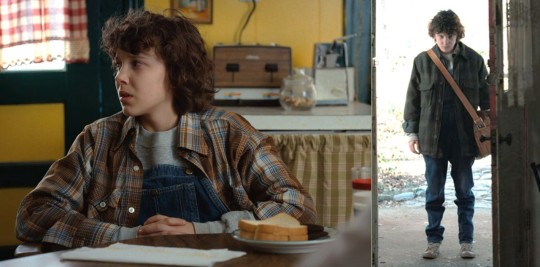
When she goes to find her mother, Becky is notably wearing the Colors of Conformity. She was pretty disbelieving in season 1 when Joyce and Hopper came to visit, but this time around, she is actually willing to listen to El. However, she is not fully trusting and calls the Hawkins PD to let them know El is there, causing El to run off. Her use of this color palette feels like a way of telling us that Becky is trying to force herself into normalcy despite the circumstances she is living with.
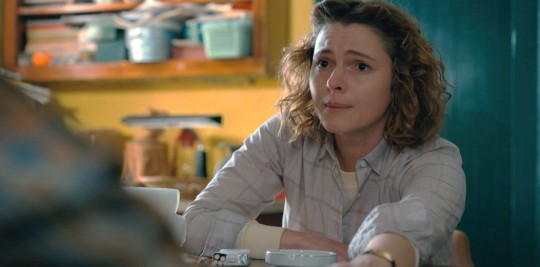
EPISODE 7
The makeover episode. This is yet another example of El getting dressed up in somebody else's clothes. Kali tries to bring El into her group, something El is initially interested in. She feels like she's been repeatedly set aside, lied to, and ignored, so she is naturally drawn to this idea of community. But joining the group means changing herself, which she tries to do (visually demonstrated via makeover), but ultimately decides against.

EPISODE 9

Hopper has been wearing scrubs since episode 6. But for the finale, he changes into jeans and puts on his Hawkins PD jacket (over the scrubs shirt). This is a jumble of everything he's worn all season: his own clothes, the scrubs, and the uniform. He has been struggling with juggling the various aspects of his life all season. He has his job, then he has the lab, and he has his home life. All of these are kept separate. At the lab, he has the Joyce and Will part of his life. At home, he has the El part of his life. And at work, all of that is a secret. But with his relationship with El out in the open and her returning to the lab with him, these separate identities he's been trying to maintain finally get to mesh.

Remember me making a whole thing out of the red shirt earlier? Lol imagine me when I got to the end and saw him wearing solid red again. Losing it. Don't worry, Papa isn't playing, but hey, how 'bout that line, "Congratulations, Pops?" While this is definitely a positive, feel-good scene versus the rather sad one before, both are turning points in the Hopper-El relationship. What we saw before was the start of dishonesty and what we're seeing here is the introduction of legitimacy. Do I actually think these two scenes are being compared intentionally by using red shirts? No, not really. But that's where my brain is.
Another connection I made that is very unlikely to have been intentional is the v-neck. That's not something we've seen him wear before, except:
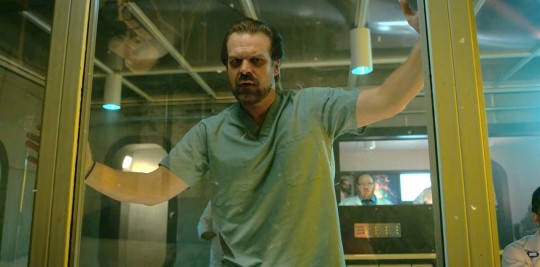
And Hopper was, likely without even realizing it, rather parental towards Will during the lab scenes. Not in terms of making decisions or imposing, but by the care and support he offered. Plus, if we return to his wacky combo outfit from earlier, the v-neck sweater really is something of a combination between his usual wardrobe and the scrubs. So that blend of his worlds stuck.
I feel like it sounds like I'm mega-stretching here, but this is just my read, not necessarily what I think the wardrobe department decided. And I'm feeling compelled to defend that.

I talked a little about this dress when I discussed Mike's Snow Ball outfit. The grey of her dress matches his sweater and the red of her belt/polka dots matches his tie. Them matching one another is a very simple way of showing that they are focused on each other.
I am dying to know who picked this dress out, though. Where did it come from? Who shopped for it? Hopper? Or is this like when he had someone else go buy a shirt for him in season 3? I'm just...so curious. What we DO know is that it wasn't El because Hopper had to convince Owens to let her out for this one night. She was not on a dress shopping spree. So as we come to the conclusion of season 2, we have still not seen El's own sense of style. I do think her hair here is really interesting. It's similar to the way Kali and co had it slicked back, but it's curly too. It's her hairstyles from season 2 (flashback hair excluded) combined.
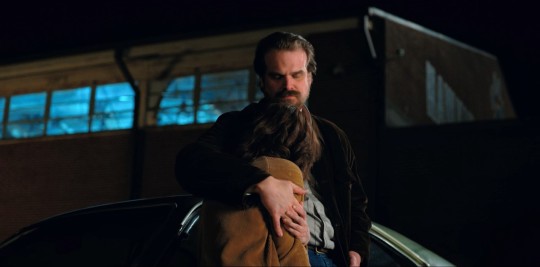
This is Hopper's second outfit since he reunited with El and also does not contain any plaid. If I hadn't already seen season 4, I'd guess that this meant that the plaid signified his single loner-in-the-woods era and now that it's over, he isn't wearing flannels anymore. However, his season 4 finale look contained one, so I'm full of shit I guess. Can't win 'em all. I have no other hypotheses about this outfit.
Other Season 2 Wardrobe Analyses: Mike & Will Nancy, Jonathan, & Steve Lucas, Max, & Dustin
#el hopper#jane hopper#jim hopper#stranger things wardrobe analysis#st season 2#my dumbass post#stranger things 2
8 notes
·
View notes
Photo

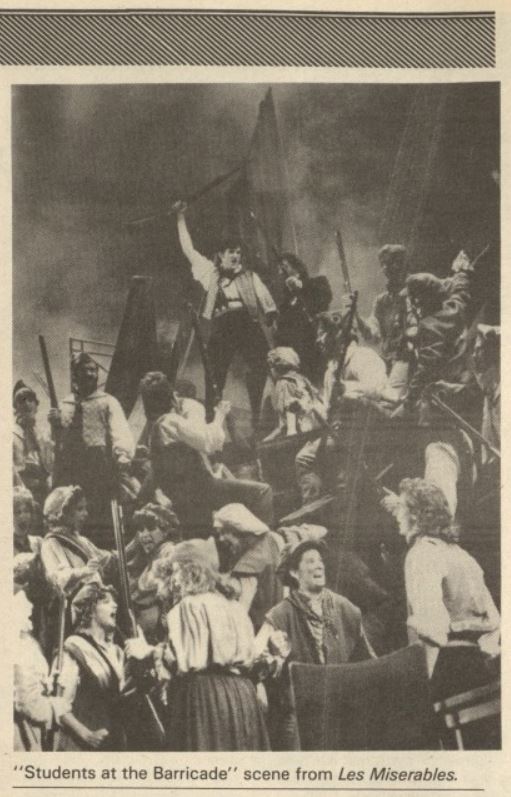
Source: the Bay Area Reporter, 9 November 1989
Not often do grossly over hyped pieces of theatre live up to the expectations they engender. Les Miserables, the spectacle of this decade’s dramatic spectacles, is a fabulous exception. As seamless a production as ever has been mounted, the musical works like a battalion of well-oiled clocks as it justly earns a place in stage history.
The element that most recommends Les Miserables is its respect for its source. Victor Hugo’s mammoth 1,000-plus page novel is rendered faithfully in content and tone. One might expect a work of such literary complexity and size to become somehow diminished or trivialized when adapted for the stage. Novels often do not transfer easily to visual media. With Les Miserables, the main question before writers Alain Boublil and Claude-Michel Schonberg was how to convey adequately the politics, philosophy and view of humanity in Hugo’s novel.
Drama Before Technology
The creators of Les Miserables came up with the answer: practical and simple staging, executed with a precision to make NASA weep. Yet as large, expensive, and grand a set as it utilizes, Les Miserables does not favor high technology over basic dramatic tension. The tricks Les Miz pulls out of its hat are big, but, actually, they are not new. They are just done better (and with bigger budget to support them) than any previous. And for all the pyrotechnics, this is still very much an actor’s piece.
The basic unit of the set is an almost perpetually moving turntable, built-in and flush with the stage floor. On this symbolic wheel of life revolve the fates of Hugo’s characters. [. . .] Played out against the citizen and student riots of 1832 Paris, Les Miserables is an eloquent appeal for freedom of expression, civil rights and commitment to the cause of justice.
Wringing Grandeur
There are many who shed tears over the wringing grandeur of Claude-Michel Schonberg’s score, with lyrics by Herbert Kretzmer. The original French text by Alain Boublil and Jean Marc Natel holds up well in translation, although for the die hard Les Miz-ophile I suggest the original French cast recording. Somehow the soundtrack in its native language raises goose bumps that the Anglo version does not. However, potent though it may be, Les Miserables is not so much a tear-jerker as it is a heartstopper. The musical is constant assault on the senses, especially the ears and eyes. If it causes some to whip out the hankies, so be it. But, ultimately, that will not be Les Miserables’ lasting gift.
A Lesson in Stagecraft
Les Miz is an object lesson in efficient stagecraft. Aside from the aforementioned turntable (a device as old as the Greeks), the only major set pieces are two levered wagons which come together at the end of Act I to form a barricade for the student revolutionaries. Before this, they hinge and rotate to form a Paris backdrop, a balcony, a street scene.
John Napier’s design is actually very mundane, refreshingly so, in fact. The set, along with David Hersey’s exquisitely designed and produced lighting, precisely establishes mood, place and tone. We are overwhelmed not by the magnitude of the set, props, costumes and effects. Rather, we are appropriately impressed with how well, and simply, they are used. There’s no denying that Les Miserables is an event. The production deserves to be, but it’s too bad people cannot discover it without first being bombarded by the soundtrack, the TV commercials, and the ubiguitous [sic] red, white and blue urchin posters. In an era of empty-headed epics such as Phantom of the Opera, Cats, Starlight Express and Chess, it’s encouraging to see a musical with a soul almost as big as its budget, and one not entirely overshadowed by it. No matter how many times the stage turns round, or how dense the onstage smoke, a beautifully sung “to love another person is to see the face of God” never loses its power to move. Les Miserables Curran Theatre, 445 Geary St. Tues-Sat, 8 p.m.; Sat matinees, 2 p.m.; Sun matinees, 3 p.m. $16-$50 243-9001
17 notes
·
View notes
Text
Films You’re Not Supposed To Like But I Do Regardless
Neglected Treasures and Guilty Pleasures
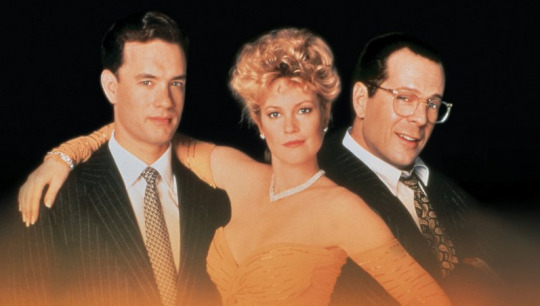
1. The Bonfire of the Vanities (1990)
Yes, it has its flaws, and perhaps the most ill-fitting soundtrack of any Hollywood movie yet made, but judged separately from its much more celebrated source material, I still feel if this film had been made by Frank Capra in the 1940s it would be considered a classic.
★★★★★★★★☆☆
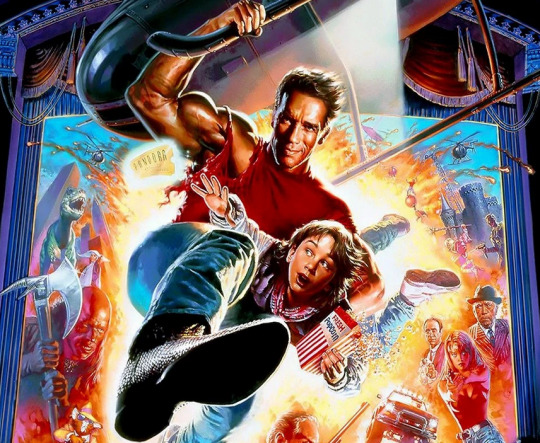
2. Last Action Hero (1993)
I've heard this film described as "a joyless, soulless machine of a movie" and "a perfect example of cinematic-self hatred", but I think that's all a little harsh: personally, I see an absolute one-off, a hugely over-budgeted action blockbuster that is a meta-parody of itself. There's quite a bit of it that doesn't work but the bits that do are a joy and unlike anything else you'll have ever seen.
★★★★★★★★☆☆
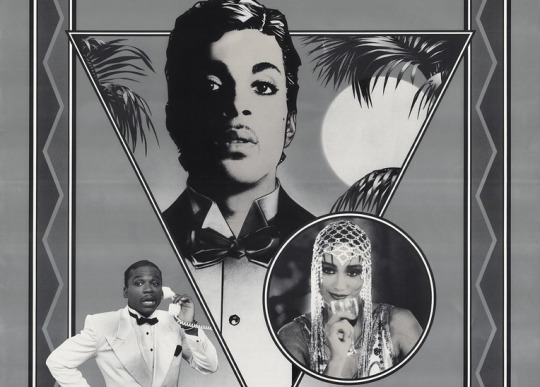
3. Under the Cherry Moon (1986)
The great weakness of the follow-up to the phenomenally successful Purple Rain is that there's no room for music (very similar to '8-Mile'). But in its place there's a quirky black & white fantasy tribute to '30's romantic comedies, and Prince is much funnier than most would imagine.
At root it's a vanity project, and something of a silly mess, but it's not the abomination it was made out to be when first released, and if you're a fan of the man there's a lot to love.
★★★★★★☆☆☆☆
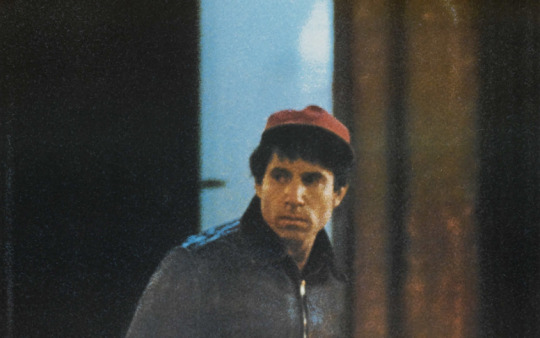
4. One-Trick Pony (1980)
Paul Simon's one and only movie was a terrible flop upon release but his story of a 60's one-hit wonder still touring and trying to make a comeback is not really all that bad. If it had been released a few years earlier, I think it would have fitted in more with the gritty, downbeat American films of the time, but at the turn of the 80s, in the immediate aftermath of Punk and New Wave, it got kinda lost.
A small, thoughtful, slightly amateurish film, it's just about worth seeing for Lou Reed's cameo alone.
★★★★★★☆☆☆☆

5. Stardust Memories (1980)
I can't for the life of me see what everyone hated about this one. Yes, it owes quite a debt to Fellini, but on the other hand there'd never been another American film like it, and this is prime Woody Allen, up there alongside Hannah & Her Sisters, Manhattan and Annie Hall with his very best, perfectly blending comedy and pathos into something that is neither but all his own. My very favourite film of all time.
★★★★★★★★★★
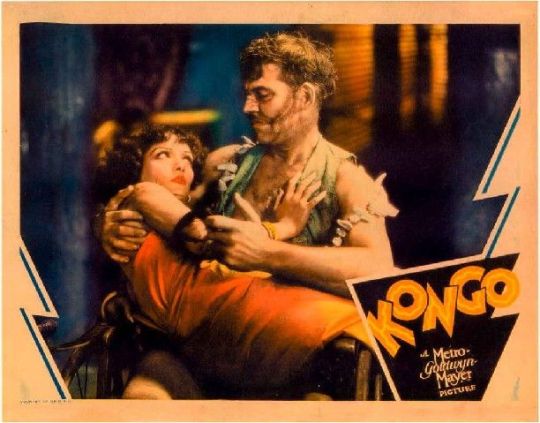
6. Kongo (1932)
Don't really want to say anything to spoil it, but this luridly twisted pre-code nightmare genuinely does have to be seen to be believed. It would be hard to get away with what happens in it now, so it's amazing they got away with it then.
★★★★★★★☆☆☆
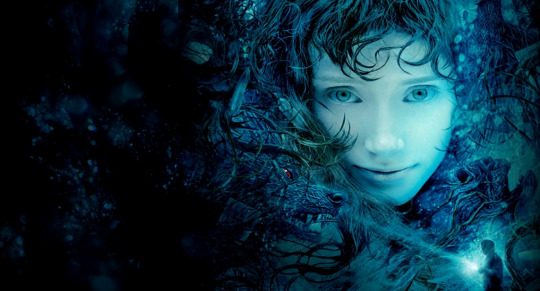
7. Lady in the Water (2006)
M. Night Shyamalan made one great movie (The Sixth Sense), two very good movies (The Village and Unbreakable), a seemingly never-ending stream of diarrhea (everything else), and then this, which is kind of a bit of all three. It is an incoherent and sloppily pieced-together meander but there's a delightful film in there somewhere trying its best to get out.
★★★★★★☆☆☆☆
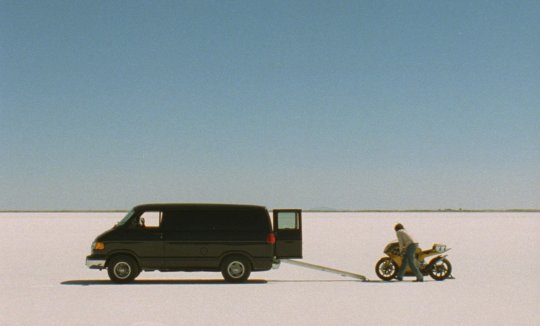
8. The Brown Bunny (2003)
The only thing anyone remembers about this is the blowjob, but the whole film is a beautifully shot, deeply intimate and narcissistically self-indulgent work of art, that deserves a much larger cult following than it presently has, and eventually will get.
★★★★★★★☆☆☆
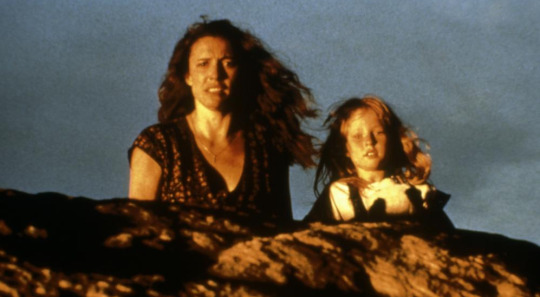
9. The Rapture (1991)
Every time you think you've figured out what this film is saying, it switches up on you and heads somewhere else. It starts out like some straight-to-video softcore, seemingly gets religion in a big way 20 minutes in, then gets very very dark and ends up somewhere all its own.
When watching this for the first time, set a timer on your clock to remind you every 20 minutes to ask yourself "who the hell put up the money to make this?!"
★★★★★★★★½☆

10. St. Elmo's Fire (1985)
Usually overlooked and/or derided 80's 'Brat Pack' movie, looking like a John Hughes misstep but really just a younger version of 'The Big Chill'. And like that film, it's a warm, funny, and well-acted meditation on the complications of growing up and adulthood.
The worst thing in it is Rob Lowe playing the saxophone.
★★★★★★★★☆☆
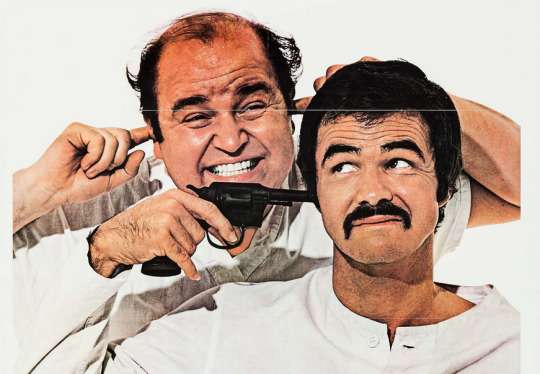
11. The End (1978)
A full-length comedy entirely about a man trying to kill himself still seems a very strange career decision for action movie superstar Burt Reynolds, but I always rather liked it.
★★★★★½☆☆☆☆
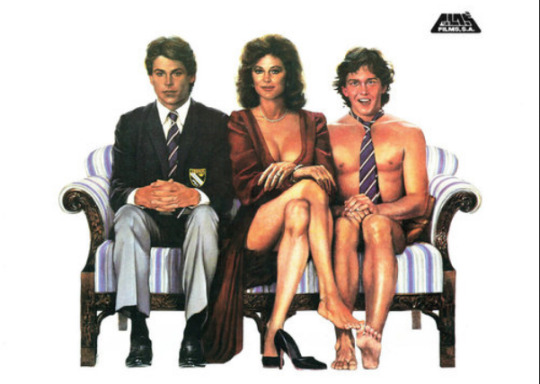
12. Class (1983)
Another rarely mentioned 80s 'teen movie' that has a lot more tenderness and depth to it than the 'Porkies'-type comedies it usually gets lumped in with.
Along with 'St Elmo's Fire', Andrew McCarthy and Rob Lowe's best movie.
★★★★★★★½☆☆

13. The Ghost Train (1941)
A completely forgotten time capsule of British wartime comedy, now seeming to come from not only a different age but a different planet. Creaky and atmospheric, sort of an English take on something like 'The Cat and The Canary', but a pretty successful star vehicle for the sometimes very funny, often very grating Arthur Askey.
★★★★★★☆☆☆☆

14. Death Proof (2007)
Quentin Tarantino's 'Grindhouse' double bill never really took off the way he wanted to, but seen alone, this is one of his best second tier films - not as good as Pulp Fiction, of course, or Reservoir Dogs or even Jackie Brown, but I would say better than the much higher praised Django Unchained, Inglourious Basterds and Hateful Eight.
A gloriously lurid tribute to the satin-jacketed stuntman movies and slasher films of the seventies, it's enough of a one-off labor of love to be treasured for itself.
★★★★★★★★☆☆

15. 1941 (1979)
Once a chaotic mess, the Director's Cut turns this into a pretty watchable movie with some great set-pieces.
★★★★★★☆☆☆☆
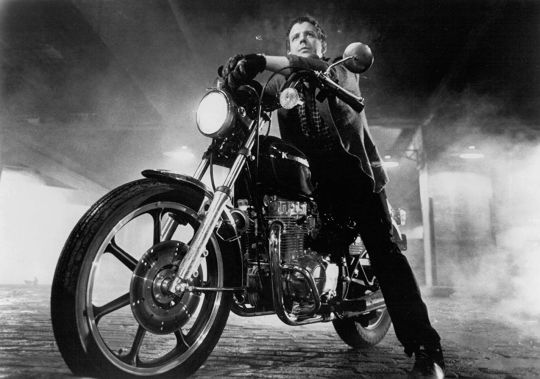
16. Rumble Fish (1983)
Francis Ford Coppola's last great movie was maybe too small-scale and quirky to get the attention it deserved, but it's a twilit, no-man's land meet-up of a dream of a 1950s that never was and some greaser 80's punk noir, based on pages from a teenage novel and ending up feeling more some kind of black & white myth. It's a smokey, jazzy, melancholy movie all in a world of its own, and Mickey Rourke was never so beautiful or perfect again.
★★★★★★★½☆☆
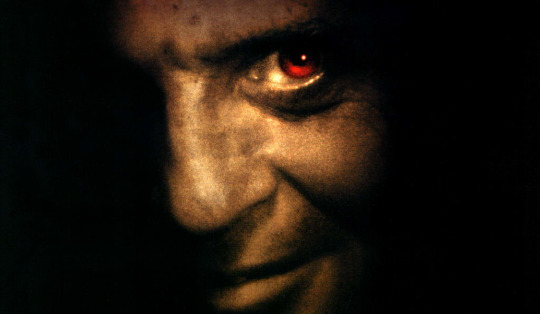
17. Hannibal (2001)
Lambasted for pushing the powers of Dr Lecter some way beyond those of mere mortals, but really not much more than, say, Sherlock Holmes, this is a fantastic thriller with Anthony Hopkins on toppermost form. If they'd managed to keep Jodie Foster aboard it would have been perfect.
★★★★★★★★½☆
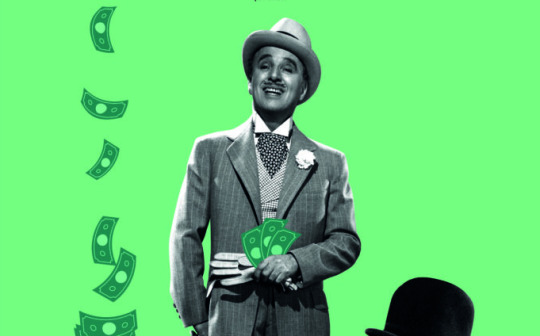
18. Monsieur Verdoux (1947)
The film that finally drove Chaplin from Hollywood and America, it's a failure as a comedy but a triumph as a uniquely cynical take on the morality of murder and war, out of step with everything else made in that period of time and most things since.
★★★★★★★☆☆☆
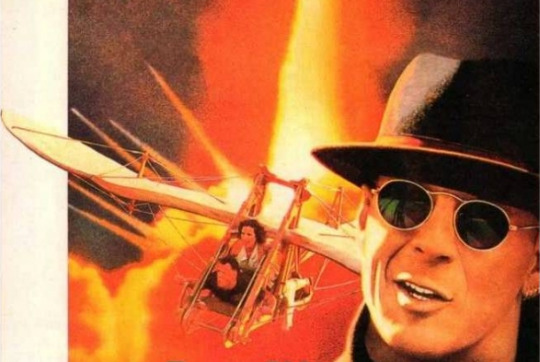
19. Hudson Hawk (1991)
As with many other things in this list, it's a bit of a self-indulgent mess but a lot of fun too, if you're willing to get on board and go along with it.
★★★★★½☆☆☆☆

20. Unbreakable (2000)
Not a flop, and not forgotten, but still undervalued for what it is. Unbreakable introduces superhuman powers into a recognizably everyday world in a far more believable, original and powerful way than many much more famous 'superhero' movies since.
★★★★★★★★☆☆
18 notes
·
View notes
Note
Spirit tracks is amazing, the train theme is great and its very under-appreciated in my opinion
grab a blanket and and get ready to lie down in the can of worms you just opened. my sincerest apologies in advance.

Legend of Zelda: Spirit Tracks for the Nintendo DS is a criminally underrated LOZ game with a brilliant soundtrack, phenomenal visual design (especially the characters), and well-made dungeons that stay true to many of the tool-oriented puzzle mechanics of previous games while adding its own unique flair in a variety of ways.
The Premise: The Natural Successor of The Boat, Apparently
Trains.
It’s bizarre. It’s totally unrelated to anything mildly Zelda. Why did they choose it? Who fucking knows. My guess is they were trying to survive off the boat hype of Wind Waker with a brand new type of locomotive. I don’t care because it made the Lokomos.

look at these dudes. these little guys. disabled musicians, absolute icons. i love them.
Anywho, the train as a mechanic is kinda just a reformatting of the boat in Wind Waker (and to a lesser degree, Phantom Hourglass). A weird choice, considering the overworld navigation of WW was a biiiiiiig point of criticism for that game. The HD version did a lot to repair it. ST has similar flaws but ultimately is no more unbearable than its counterpart. It seems the biggest change that having trains made, other than being fucking ridiculous, is in terms of the plot.
The Plot: Zelda Gets a Personality and a Big Fucking Sword
I doubt anyone who still owns a DS cares enough to go track this game down but I’ll say it anyways: spoilers.
Across the five kingdoms, over land and underwater, spreads a lace of train tracks, acting as the spiritual chains that bind some Evil Train Dude in the earth. Engineers are a revered class because they maintain the tracks in service of the spirits. I bring this up because credit needs to be given to the motherfuckers who were told to integrate trains into Zelda lore and who tried their fucking best.
Anyways, Zelda fucking dies, like, almost immediately. She gets murked by Sasuke 2 and a demon politician (who has one of my favorite villain themes).

Link gets his tiny ass kicked because he’s not a twink swordsman, he’s a twink engineer.
Zelda is a ghost now and she is so fucking mad about losing her body. She is so mad she will accompany you on your whole quest just so she can strangle Chancellor Cole with her bare hands. This means not only does she get to develop a genuine friendship with Link but also an actual personality (Tetra notwithstanding). Plus, she plays a big role in dungeon gameplay.

She possesses a darknut and gets a huge fuckoff sword. She uses it to kick ass and does so without mercy. The controls are wonky at times but I can and will forgive it for the novelty of letting Princess Zelda do harm.
Side Quests Including but Not Limited to Extremely Divorced Bunny Man

Here he is. Bunnio. My favorite NPC. He divorced his wife to go make a rabbit sanctuary in the middle of the woods. He will pay you to catch bunnies for him and I always catch all of them because I’d die for him. If you meet his ex-wife, you can choose to bring her to the sanctuary where she will promptly tear his ass apart. However, she quickly realizes that love often means accepting your partner’s unconventional hobbies and so she decides to stay and take care of the sanctuary with him. LOVE WINS BABEY!!!!!

On a brief note, I wish so badly that the Anouki were in more Zelda games. They are bastards and idiots. They have extremely strong feelings regarding facial hair. I adore them.
Why It Failed, Aside from the Obvious
There are a lot of reasons why ST didn’t take off. The premise itself was enough to turn people off because its fucking trains. The DS wasn’t a popular console among classic Zelda fans at the time. However, I’ll still posit my own theory for what I think was a big factor: Phantom Hourglass.
PH was Spirit Tracks’ predecessor, also on the DS, and it is a grueling experience to play. It has a super repetitive dungeon mechanic (the ocean temple) which starts pissing you off by the second time you visit it. It adds a time restriction (the hourglass) that at first, appears to add urgency, but which you quickly realize is just the most boring and arbitrary way to force your players into perfecting their speedrun. The fact that it followed after Wind Waker, one of the best iterations of the series and the introduction of Toon Link, just made it more of a disappointment.
Basically, I think ST was doomed from the start because PH set a terrible standard for LOZ DS games and further cursed the Toon Link IP that was already being met with hostility by Zelda gatekeepers when WW first came out.
TLDR: Being Charming and Bizarre is Enough Sometimes
The fact that this was one of two of my first Zelda games I ever played (the other being PH) definitely makes me several orders of biased. Because I wasn’t familiar with the traditional combat and overworld navigation of typical Zelda games, I wasn’t judging it by that metric when I played. therefore, I was able to enjoy the game for what it had rather than compare it to what it had changed.
It’s not a groundbreaking game. It doesn’t expand upon the existing LOZ universe with new deep lore. But its not supposed to. It’s just a funky lil Zelda game with all the cute characters, off the wall plot, and creative puzzles that make the franchise so popular. It’s cute, creative as hell with what it has and it knows what it is. It’s a lighthearted exploration into something weird, sweet, and unique. And damnit that’s just what you need sometimes.

#thank you anon for giving me the opportunity to write the essay i’ve always wanted to write#i needed this infodump#legend of zelda spirit tracks#lozst#borble torble#long post#long
170 notes
·
View notes
Text
Summer of Soul (...Or, When The Revolution Could Not Be Televised): Original Soundtrack Review

(Legacy)
BY JORDAN MAINZER
The existence of Summer of Soul (...Or, When The Revolution Could Not Be Televised), Ahmir “Questlove” Thompson’s Academy Award-nominated documentary about the 1969 Harlem Cultural Festival, is nothing short of a miracle. Culled from never-before-seen footage of the summer concert series in Mount Morris Park, the film positions the the monumental event organized by singer and activist Tony Lawrence as just as important of a cultural shift as Woodstock, sans the white boomer heroification. For six weeks, the most brilliant Black artists of eras old and new graced the stage, and Summer of Soul sports many jaw-dropping highlights. Mahalia Jackson and Mavis Staples singing “Precious Lord, Take My Hand” in dedication to the murdered Dr. Martin Luther King Jr. A drum solo from a 19-year-old Stevie Wonder. Nina Simone asking the crowd, “Are you ready, Black people...to smash white things, to burn buildings,” launching into a David Nelson poem, foreshadowing the decades to follow of violent institutional racism and an ignorant white populace. It’s at once a relic of the past and fresh and raw.
How does the Summer of Soul soundtrack, then, stand as a separate experience from the film, one that lacks not only the sociohistorical context of the performances and the faces and of the performers themselves, but Wonder’s drum solo and Hugh Masekela’s trumpet blares? For one, though the festival took place over weeks and the film does have some talking heads, the soundtrack is truly structured like an album, or at least like one amazing concert. Lawrence introduces the Chambers Brothers and occasionally pops in like an emcee, to explain how special it is to have St. Louis’s The 5th Dimension in Harlem for the first time, reveal a surprise performance from The Temptations’ David Ruffin, and sarcastically and nonchalantly refer to Gladys Knight & The Pips as “some folks.” For the most part, like the film, the music does the talking. “I’m goin’ uptown to Harlem / To let my hair down in Harlem / If a taxi won’t take me, I’ll catch a train / I’ll go underground, I’ll get there just the same,” sings Lester Chambers on the opening track. In a sense, that sentiment hovers throughout Summer of Soul: Black folks, even Black artists that could cross over into predominantly white rooms, finally found a space of true acceptance, at least for a few weeks at Mount Morris Park.
The mood throughout the Summer of Soul soundtrack is varied, highlighting the layered complexity of the festival itself. From “Uptown” goes B.B. King’s “Why I Sing The Blues”, a song about the history of mistreatment of Black folks in America, to The 5th Dimension, the countercultural “Black group with the white sound,” a label Marilyn McCoo laments in the present day in the documentary. As much as The 5th Dimension wanted to spread love, as do The Edwin Hawkins Singers with “Oh Happy Day”, one of gospel’s first forays into the mainstream charts, it’s The Staple Singers and Nina Simone that linger. We’re used to hearing Mavis Staples’ guttural prayers at music festivals these days, but for many at the Harlem Cultural Festival, they were witnessing a master for the first time.
The crossovers are also surefire hits here, and not just Sly & The Family Stone, the only band to appear at both the Harlem Cultural Festival and Woodstock. As much as you hear about Carlos Santana performing at the latter, Mount Morris Park was a true fusion of Latin, African, and Black American influence, a sense of solidarity among the oppressed from which white musicians stole. “The blood of mankind flows in me,” sings Ray Barretto on “Together”, in between Mongo Santamaria’s “Watermelon Man” and Herbie Mann’s version of “Hold On, I’m Coming”, the latter replete with an all-star band of screechy rippers. The time period also represented an increasing interest in Afrocentric art and modes of thought; Abbey Lincoln and Max Roach’s “Africa” offers a sense of hope before Simone’s realism.
If Questlove’s documentary is one of the best and arguably the most important concert film ever made, you could argue that its soundtrack is a worthwhile bonus. But as an accessible introduction to a once forgotten moment in cultural history, its widespread potential is nothing short of powerful, its aura nothing short of awe-inducing.
youtube
#album review#ahmir thompson#mavis staples#Summer of Soul (...Or When The Revolution Could Not Be Televised)#legacy#legacy recordings#ahmir “questlove” thompson#questlove#academy awards#tony lawrence#woodstock#mount morris park#mahalia jackson#dr. martin luther king jr.#stevie wonder#nina simone#david nelson#summer of soul#hugh masekela#chambers brothers#the 5th dimension#the temptations#david ruffin#gladys knight & the pips#lester chambers#b.b. king#marilyn mccoo#edwin hawkins singers#the staple singers#harlem cultural festival
7 notes
·
View notes
Note
They said that's a new recording, but it sounds like the same one Lucy uses whenever she performs. Does that mean she doesn't have a powerful high E or did they play around with the synthesizers?
Well, I think they meant that it's a new recording of the title song compared to the other cast recordings, meaning it's a version of the title song that's not from the original London cast recording, the 2004 movie soundtrack, or the 25th anniversary recording. It's not, like, a new recording of the cast since the last time they did the show or made a recording or whatever.
That was also my guess when I heard about it and especially when I saw that it might only be the title song, that is, that they would take the pre-recording of Killian Donnelly and Lucy St Louis that already exists for the show and just do some sound editing on it. Judging by your ask, that's what they did; it's certainly the easiest route they could take. So Lucy St Louis may very well have a great high E, but since they chose to use the pre-recording she did almost a year ago rather than have her re-record the song, we won't know, sadly.
2 notes
·
View notes
Text
BioShock’s Soundtrack Timeline Quirks and Hiccups
Here’s a question customers have posed while shopping around in this record store: “Is the BioShock soundtrack historically accurate?”
The short answer is no. This is of course including a presumption of a distinct cutoff year. If on the other hand, you would consider the reverse, “Is the BioShock soundtrack historically appropriate?”, well we shall see.
So let’s briefly break down the soundtrack of each game.
-
In the first Bioshock, the game opens with the year 1960 before taking us down to the underwater city of Rapture. However, Andrew Ryan had cut off contact with the Surface some time before, coupled with the Rapture Civil War officially starting on New Year’s Day in 1959. Granted several songs in BioShock were recorded in that last decade through the 50s including “Danny Boy” (1952), “Papa Loves Mambo” (1954), “It’s Bad for Me” (1955) and so on.
Frank Fontaine’s smuggling operations could account for the fact of the very late 1959 release dates of Bobby Darin’s “Beyond the Sea” and Noël Coward’s “20th Century Blues”, however Fontaine allegedly died in September 1958 according to the newspaper article in the Rapture Standard.
Even with Fontaine’s shenanigans, it doesn’t account for the 1966 version of Patti Page’s “Doggie in the Window” or the 2004 version of Cole Porter’s “You’re the Top” as seen below. Other songs include the assorted instrumental tracks recorded in the 1990s such as “The Ballroom Waltz”, “And All the While I’m Loving You” or even the 1966 song “Academy Award”. Lastly, there is still the mystery of the numerous instrumental guitar and violin songs supposedly performed or inspired by Django Reinhardt used in BioShock.
Creative Director Ken Levine obliquely mentioned the problem of using re-recordings and alternate versions of songs in a 2007 interview with Electronic Gaming Monthly.
...Or I would research on Wikipedia or talk to my dad, and then I would go and listen to little snippets, and I'd ask myself, "Does this feel like it belongs in Rapture?" [Dealing with this era of] licensed music... is a very complicated process, because generally you're dealing with people who are dead and their lawyers are dead. The rights are often very complicated, and so a lot of times we'd want a song and we wouldn't get it. We'd have to find another person who performed it, or another version of the recording or something like that. We had to be fairly flexible.
-
Overall, BioShock 2 does have the most historically accurate soundtrack of the series, excluding the songs reprised from the first BioShock. The game ostensibly takes place in 1968, or 10 years later from 1958 according to the opening titles.
All things considered, its only soundtrack transgression is using the 1976 version of “Daddy’s Little Girl” as seen below.
Aside from that, its newest songs unique to the game are 1945′s “Dream” and “It’s Only a Paper Moon”. Many songs trend older towards the 1920s and 1930s, reflecting the older portions of Rapture seen in the game with some of the oldest tracks being 1929′s “Daddy Won’t You Please Come Home” and “Nobody Knows You When You’re Down and Out”.
-
BioShock Infinite and the floating city of Columbia introduces time as central plot point and with it some interesting soundtrack implications. Keeping in mind the setting is 1912, its soundtrack can be broadly divided into three categories
Modern covers of existing period songs were recorded especially for the game such as “After You’ve Gone”, “Will the Circle Be Unbroken”, and the Scott Joplin rags.
Deliberately anachronistic songs are provided as a plot point courtesy of Messrs. Albert Fink and Scott Bradlee rearranging modern songs to sound period such as “Girls Just Want to Have Fun”, “Fortunate Son”, “Tainted Love” and so on.
Lastly there are the period songs meant to evoke the flavor of the 1912 setting. While some are authentically of the era including some very old Edison cylinders, quite a few bleed into the 1920s and 30s including “Ain’t She Sweet” (1927), “Button Up Your Overcoat” (1929), and “St. James Infirmary” (1930). Bessie Smith manages to crossover to both cities in both BioShock Infinite and BioShock 2 with “I’m Wild About That Thing”, “Nobody Knows You When You’re Down and Out”, and “Need a Little Sugar in My Bowl”. In addition, several recordings are presented “live” in the game, but were recorded much later such as the prison work song recorded by Alan Lomax, “Black Gal” in 1959 and “Shake Sugaree” recorded in 1967.
Lastly, Burial at Sea features a coda. Both Patsy Cline songs “She’s Got You” and “Back in Baby’s Arms” were recorded in the 1960s, well after the 1959 date of the events of the game. However in a tragic twist of fate, she would die shortly after recording the songs in a plane crash.
Creative Director Ken Levine again mentioned the problem of finding music “that sounds great to the modern ear” in a 2012 interview with Wired magazine.
But one of my favorite parts of my job is choosing the licensed music. BioShock Infinite is set in an interesting time because it’s right at the beginning of jazz and blues. Music before jazz and blues is not very listenable. I mean popular music -– it’s really kind of awful. You know, the John Philip Sousa marches and stuff. And then you get jazz and blues coming in, with the early stuff like ragtime.
It’s much more challenging to find music from that era that sounds great to a modern ear. BioShock was set in 1959, so we had this huge slate of great music to choose from. But here we don’t have all the chord progressions, and the things we like didn’t exist or had just started to exist. So finding music has been a really interesting challenge...
The most important thing is that you get people to feel things. I’ll give you a hint: There weren’t flying cities in 1912 nor were there underwater cities and genetic technology in 1959 (laughs). So, yeah, you play a little fast and loose. You could argue that this is Columbia and we do things a little differently.
You’ve already heard some of the strange musical things in the game...
-
Less discerning record customers may have grabbed the wrong discs and are surprised to find the recordings don’t match what they’ve heard.
I have taken the liberty of conducting a synchronization of a number of the more unusual re-recordings which the games use instead of the originals. These are presented in the new stereophonic sound format, be advised it is recommended to have two speakers far apart to get the full effect, or at the very least avoid having two speakers that are too close together.
The original older track is on the listener’s left while the newer one used in the games are on the listener’s right.
Some of the more fantastically-minded among us down here in Rapture might be tempted to simply blame the above on those newfangled Tears. But it is the records that speak for themselves.
youtube
Patti Page’s “The Doggie in the Window”
1952 Mercury Records version (original)
1966 Columbia Records version (used in BioShock)
youtube
Cole Porter’s “You’re the Top”
1934 Victor Records version (original)
2004 version with Vince Giordano and The Nighthawks (used in BioShock)
youtube
Mills Brothers’ “Daddy’s Little Girl”
1950 Decca Records version (original)
1976 Ranwood Records version (used in BioShock 2)
The original versions of the songs are featured occasionally here with the addendum that they were not actually used in the game. They are marked with the RRR for Rapture Records Recommendation.
There are number of other instances where an artist recorded more than one version of a song, typically well before, such as Noël Coward’s 1959 “Party’s Over Now” and his slightly longer 1932 version. But that’s left for another revolution of the record.
60 notes
·
View notes
Text

☾ ˚⊹ ❛❛ GENERAL QUICK CROSSOVER GUIDE


So crossovers are usually difficult for a lot of people. So, because I tend to think about these things, I thought I would make this comprehensive list/guide to writing crossovers with me. This isn’t anything in concrete, but to get the ball rolling or to help make it easier for both sides to contribute to plotting. It can be hard when you don’t know the fandom.
FNF, or Friday Night Funkin’ is a rhythm based game around rap battles. The Protagonist (known as BF) is trying to prove himself and win over his Girlfriend’s (GF) Dad, and it spirals from there. Gameplay style, it is very similar to Dance Dance Revolution, and the music is a fast pasted dubstyle/chiptune soundtrack.
What a lot of people know FNF for, however is the Mods. Due to it being on Newgrounds, and the creators having it be open asset, many creators are able to make their own “weeks” for players to challenge their skills in. Ruv, and those within Mid Fight Masses, are one of those mods. You can find most of their lore scattered in the scenes of their week, or by going on their official FNF Wiki.
Now, what does this mean for crossovers? I put it under a read more, simply because this is going to be a lot. I’m going to explain crossover verses I have. How I make them, and how YOU could have your character be in the FNF verse quite easily. So go under the read more to continue reading.

☾ ˚⊹ ❛❛ RUV IN OTHER UNIVERSES
Here are some just ideas that I came up with. While not EVERY interaction will work with these, they are ideas. They’re meant to kick start ideas and inspirations. I do not consider these full verses until I’ve talked with the other mun to make sure that they are okay with it. These can easily be changed, and swapped out for different things. My main goal here is to try and keep Ruv down to his core elements while fitting into a new setting.

POKEMON- Ruv, along with Sarv run the church- which she has turned into a sanctuary and a Nursery. Much like in Canon, Sarv is supernatural, and Ruv as a run away criminal vowed his life for all eternity to protect her. With church’s going out however, the next next step would be a PokeNursery. Ruv acts as protector of the Nursery from trainers and groups alike. He usually is seen sitting on the roof, throwing pebbles at kids or passerby’s who irk him in some way. You can always find his Onix, his Low-Key Toxtricity, and his Absol around him or the nursery at all times. He does still have his strength, speed, and other abilities. The “face” he has is also a mask- an attempt to hide his identity as the wanted criminal.
OWL HOUSE- Ruv was a wanted criminal for the longest time. His magic, due to where he was born was a lot less like those around him. He could fit into the covens, but anything he did reflected back on him. Living alone, and learning to just modify himself he became a wanted criminal with a bone breaking shout. However all of those times soon came to a stop as he met the winged mistress he stays with now. Protecting her (though she is much more than capable of protecting himself) she runs one of the many sects in the area. It isn’t the best building, but it’s out of the way and he usually isn’t spotted. However, unfortunately his past comes back to haunt him. He has no choice, and begrudgingly assists the Guards to repay for his crimes. Tied to Sarv through magical bonds, he has made it clear to those in charge and to her- should something come between his duty as a guard or her, he would chose her a million times over.
DUCKTALES- Ruv is the petrified remains of the guardian of St. Sarvente. Awoken as the earth was shifted off of it’s orbit and forced into something it’s not, the callous guard is in search of the one he calls Sarvente, whom he claims is the Ruler of Souls and the one he Vowed to Protect. He is, 100% made of stone.
TOONTOWN- Stickfigures aren’t uncommon drawings. One’s as complicated as he and Sarv though usually get a few eyes. Not only that, but video game characters are always treated differently in Toontown. Maybe it’s because of a developers history, or lack there of. The story of Ruvyzvat being a heartless killer however spreads like wild flower, and while he and Sarv will primarily stay at the church... sometimes curiosity becomes too much.
KINGDOM HEARTS- FNF is it’s own world. Keyblade turned into a microphone, Ruv & Sarv are some of the first that would be met. Despite their challenge, they are rather distanced from the troubles of the Darkness and Light and would be semi-good companions.
THE BLACKOUT CLUB- Ruv is a 16. Any day will be the day that a voice will end up taking over, merging with his mind. That’s fine. Much like how Seed-The-Grudge would want, he’ll just get revenge.
HAZBIN HOTEL / HELLUVA BOSS- Ruv ironically enough is one of the few in Hell who does not make him dead. In fact, in some cases that can make him extremely rare. This crossover he IS able to accompany Sarvente into the Underworld, and follow her on her treks through it. While most assume he is a dead sinner, he usually just doesn’t answer. However something about being here and meeting those who reside within the land sets him off. He’s a tad more feral, and a tad more willing to go to the violent answer.
PORTAL- Violence core. What else is there to say? Alternatively, him being a test subject would be fascinating, especially if he was grabbed post-vow. The man is immortal, and therefore would have messed with the tests just by the fact that there is only way for him to die. Death isn’t the worst thing to happen to a man however, and he does still feel pain.
RWBY- Ruv has the ability to manipulate sound waves, specifically his own). Trained with great strength and and even greater speed, his form of combat is continuously dodging as he looks for a weak spot. Weapons of choice are shot gun snow boots, and his sickle that doubles as a short sword.
DOCTOR WHO- Sarv has the ability to create portals. While they are MEANT to be used to intergalactive travel, but instead parallel world travel that in of itself is monumental for a lot of DW plots. Ruv and Sarv can easily go from one universe to the next, however chose to stay in the church. Not to mention Ruv’s skills in target elimination and his abilities would make for some individuals to repurpose him into a weapon. While they have been approached by UNIT on several occasions, they always refuse. However, enough time has passed that they’re starting to notice that the couple in the church aren’t aging...
FNAF- RUVYZVAT and SARVENTE were creations of Fazbear Entertainments as karaoke machines... if we want to go the robot route. If we want to go the normal person route, Ruv was hired by Fazbear’s because it’s one of the few places that doesn’t do a background check, and when he said he wanted to wear a mask as part of the work outfit they were all for it. He runs the karaoke machine though. Stays away from quite literally everyone. While he isn’t the infamous killer of children here, he does have a reputation of his own that he is running from, and that does tend to make him silent.
BATIM- Criminal on the run stumbles into the wastelands formerly known as Bendy’s. Actually enjoys it at first because the cartoon was popular when he was a child. ALT. Stickman drawing of one of the artists come to life. Usually pretends to be Lost One, but when he’s alone with another (Sarvente) they turn into their stickman version selves. Has the ability to jump between 2 and 3 dimensions, but none of the strength or voice.
PSYCHONAUTS- Agent Ruvyzvat, Russian sector. Ruv is working for the Psychonauts in some weird, turning event. Mainly because the sole woman that he trusts and saved his life, Agent Sarvente brought him in. The two are inseparable, and despite Sasha and Nein being infamous for their clinginess, these two take it to a whole knew level. Ruve’s “loud voice” is actually a psychic ability he can use outside of the mind to jumble and confuse thoughts and has no damage on anything physically in the present.
GRAVITY FALLS- Sarvente is a Demon, much like Bill. Where sa Bill desires nothing but chaos and madness, Sarvente is trying her best to keep the world like it is and preserve it’s beauty. Seeing such beauty in a runaway criminal, she and he run to the forests of Oregon. Throughout Weirdmageddon, neither managed to be captured or turned to stone, however Ruv seemingly gained his incredible voice abilities. Now, they live in a semi-collapsed church out in the forest. Sarvente always asking those who come her way to join their church, Ruv is suspicious why such events would happen in such a small town, and is distrusting of most everyone he sees.
DETECTIVE CONAN / KAITOU KID / ANY ANIME OR SERIES LIKE THAT- VERY infamous criminal. Take his “Wanted Dead or Alive” that exists in all other verses, and ramp that up quite a bit. Usually wears a mask whenever he is committing a crime. He does seem to be in it for the fun, though it’s hard to tell with the stoic and expressionless looks. That being said, he does seem to have a very clear goal of what he wants. There are no patterns to where he hits, or what he takes. From wallets of people off the streets, to priceless artifacts. He’ll find where Sarvente went, and how they were able to change her mind in such a way.... how they could corrupt her.
MODERN / NON-EXTREMELY FANTASTICAL- Ruv is honestly a rather down to Earth individual, in some terms. He is untrusting of EVERYTHING, but also due to his own strengths finds little that fear or challenges him. Keep him mind he did make a deal with Lucifer (or his Lucifer) for Immortality for protecting her. While he will always be doing things on his own, a lot of his end goals and motives will come back to her. Without her involvement, he is a walking, talking, machine of destruction with no sway on which side he decides to tear apart.

☾ ˚⊹ ❛❛ GENERAL STOPPING POINTS FOR WANTING TO PLOT

DON’T KNOW THE WORLD YOU’RE FROM / YOU DON’T KNOW MY LORE. - That’s fine. I can get my hands dirty. I can research. In fact I usually would love nothing more to. I love learning about new fandoms, or new media to get into. You shouldn’t be afraid of that. As for mine- It should take someone less than an hour to get through all of the links I have posted in the RESOURCES tab in my bio. I’ve timed it. So if you have an hour to spare, or 15, or just enough time to read his wiki that’s fine. He’s not from a long running show, or anything like that. You can catch up extremely quick.
WELL WHAT ABOUT A BOOK/COMIC? HOW WOULD HE FIT IN?- If we are talking about Super Hero comics, then it depends. 90% of the time I will just play up his wanted status a lot more, and make it more of a reason for an interaction. You just ran into a man who has killed hundreds. If your muse is a super hero, or a vigilante? Would you let him go? What a villain? That might make a good partner.
TV SHOW? LIVE ACTION?- Again, it depends on the type of show. Superhero follows the same above. If it’s investigative, have him be a witness. Or a falsely accused man who can prove he isn’t the guilty party. Is it more supernatural- well he did make a deal with Lucifer and is an immortal now from it. There are a million ways to spin it. Don’t look at making him a big character. Quite honestly, side characters that you pass in the street have just as much backstory, and as long as there is a plausible chance of interactions then we can work it out from there.

☾ ˚⊹ ❛❛ GENERAL IDEAS TO BE AWARE OF THAT MIGHT HELP

HE IS A WANTED CRIMINAL.- Meaning his name Ruvyzvat is known. Despite his crimes going on for decades, he is on the run and never stopped. Several city, state, countries, and possibly nations are looking for him, and looking to take him in.
HE IS ALSO AN IMMORTAL.- While he hasn’t been around forever, and nearly not as long as Sarvente has been, he HAS been around for at least 100 years, give or take some. He can be injured, but even fatal injuries heal in an almost Deadpool like way.
HE ALSO HAS SUPERNATURAL POWERS.- His speed and reflexes alone is not something to be taken lightly. He does train and fight with Lucifer on what used to be a semi-regular basis. He has moved and adapted to be able to make sure no one but the singular person he trusts is able to lay a hand on him. That isn’t to say you can’t catch him off guard. You also have his inhuman strength to worry about, but most of all his voice. His voice which could completely demolish a building, and that isn’t the full strength. He has an amazing control over it, but that certainly isn’t a trait of his to ignore.
HE IS NOT ALWAYS IN THE CHURCH. I MADE SURE OF THAT WHEN I MADE MY BLOG.- He goes on walks, and he goes on errands. He also goes to the Gym on occasion, though not as often. He enjoys walks on the beach far earlier than anyone should be awake at. What I’m saying is running into him OUTSIDE of the church is possible. That being said, meeting him IN the church is your best bet for him warming up quicker. He feels safer in the church, and therefore usually wishes to stay there.
DOESN’T FIT THE STYLE OF CHARACTERS/WORLD? - If he doesn’t fit, then I can work to adapt him into something that WOULD fit. What characteristics about him doesn’t work. This is when I would need plotting help. If, lets say it was an all animal world, we can talk about what he is, his traits, and other such things. I am always happy to not use my icons- I just like to because I think they’re neat and I worked hard on them.
WHAT WOULD HE BE DOING?- Any number of things. He likes throwing pebbles at people. He mainly guards and protects Sarvente and her things, but I know we’re talking besides this. He cannot cook, but he does actually sew, and he does read quite a bit. Working on his fist to fist fighting would be a big one. He likes secluded areas, which especially work for explorer’s and people who walk off the beaten path.
IS THERE ANYWHERE HE COULDN’T BE?- He wouldn’t be at a bar. Ruv doesn’t drink, at all. I also don’t see him at any parties unless Sarv dragged him to them. Writing starters or plotting around those are perfectly fine, but do not expect his muse to be comfortable while he’s there.
HE SEEMS OVERPOWERED.- At times, he certainly can be, but only when he feels it’s necessary. He doesn’t flaunt his abilities, and most he has are out of self preservation. If you as a mun are worried about him and what he can do, the best thing you can do is read my information, look into his wiki, and then come and talk to me. Ruv isn’t someone who will 100% abuse what abilities he has, especially since now he is trying his best to be better for her since it makes her happy.

☾ ˚⊹ ❛❛ GENERAL IDEAS TO HAVE YOUR CHARACTERS IN HIS UNIVERSE

LOCATIONS?- The Church, the back alleys, the karaoke bar (that primarily does rap battles), the Alternate dimension that Sarv made so that he can be loud and not retrain his voice.
MOTIVATIONS?- If your muse is in the FNF world, then be ready for some sick beats to be dropped. Your muse could be rescuing someone from the BBEG and going through the slew of minions to sing against. There’s always the alternative side of this of “what the hell is going on?”
MY CHARACTER ISN’T FROM THERE, SO THEY WOULDN’T FIT IN.- Well I do have a “main” verse which replaces raps with fists. Looking for someone important to them, in the search of a deep and hidden artifact within the search, the rumors of a man born 100 years ago- theres a lot to be found in the library if you looked.
WHAT DOES THE FNF WORLD CONSIST OF?- It consists of Demon Daddies, Singing Skeletons and Pumpkins, Tankmen, a Demonic Lemon Demon, Sentient Video Game Characters, and if you take the mods in you also have Demon, Angels, Ghosts, Deadly Ex’s, Bomb Headed Men-- I promise your character will fit in at the end of the day.
ISN’T HE EXTREMELY AGGRESSIVE AND HARD TO TALK TO?- He can be. He talks in very short sentences, however I do my best to give my reply enough that you can reply to. Actions, and I chose to be very descriptive with his expressions in this case. Ruv spend many years alone, and sometimes with him, actions speak louder than words. When you or your muse figure that out is up to you.
WELL WE CAN’T DO AN ENTIRE THREAD IN A CHURCH.- I never said we had to. He is more than happy to leave the church should he want, and should there be a reason. Usually, (despite what it seems) he does like helping people, so you can lure him out that way ;)

#∘⡊ ☾ ˚⊹ 𝕽𝖚𝖓 𝕬𝖜𝖆𝖞 𝖂𝖆𝖓𝖙𝖊𝖉 𝕸𝖆𝖓 ⊹ — ❛❛ v. crossover.#∘⡊ ☾ ˚⊹ 𝕴𝖙'𝖘 𝕶. ⊹ — ❛❛ resources.#∘⡊ ☾ ˚⊹ 𝕴𝖙'𝖘 𝕶. ⊹ — ❛❛ psa & updates.#∘⡊ ☾ ˚⊹ 𝕴𝖙'𝖘 𝕶. ⊹ — ❛❛ save.#i added all i could think of#just so i could kinda help out when it came to plotting but#even if we don't know each others universes or anything#this is pretty comprehensive so i hope it helps#i spent a while on it and it should be pretty helpful to anyone who wants to write with me but has no idea how#now if you excuse me im going to scream because of how long this took#∘⡊ ☾ ˚⊹ 𝕾𝖎𝖓𝖋𝖚𝖑 𝕰𝖓𝖉 ⊹ — ❛❛ headcanon.#∘⡊ ☾ ˚⊹ 𝕾𝖎𝖓𝖋𝖚𝖑 𝕰𝖓𝖉 ⊹ — ❛❛ meta.
12 notes
·
View notes
Text
Every ‘High School Musical: The Musical: The Holiday Special’ Performance Ranked
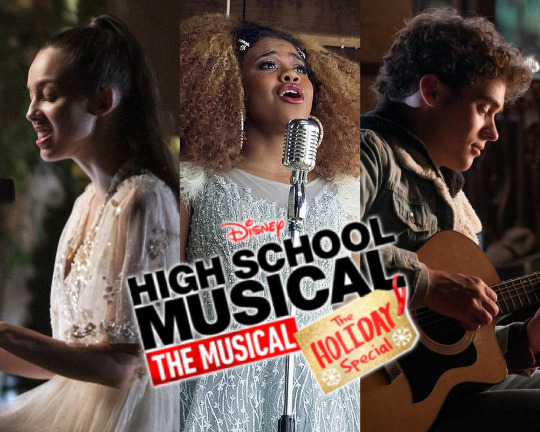
In late 2019, Disney+ premiered the first season of the highly anticipated spin-off series ‘High School Musical: The Musical: The Series’, based on the Disney Channel franchise ‘High School Musical’.
A year later, the series released its very first holiday special, in which the cast member detailed their favourite holiday memories whilst performing covers of some Christmas classics (including two originals).
Below is a ranking of every performance from the least good to the best of them all! These rankings are based on both the performance and the quality of each song. So let’s begin!

13. ‘Last Christmas’ - performed by Matt Cornett
Much like any Christmas musical special, a cover of the Wham classic was featured, and this time it was Matt Cornett (E.J. Caswell).
Whilst the vocals were fairly decent on this one, Cornett’s cover lacked the emotion, fun and vibrance that one would expect from a ‘Last Christmas’ performance. The song is known for either its high-tempo and exciting nature or its ability to captivate an audience with its emotional lyrics and somehow this version attempts neither of those.
The visuals appear to be based around Matt Cornett’s car, forcing us out of the Christmassy feel the song is used to giving off.
So with the fact that the visuals are pretty plain and how the performance lacks much feeling, ‘Last Christmas’ is unfortunately the worst performance from the special.

12. ‘Hanukkah Medley’ - performed by Julia Lester
Julia Lester is an incredibly talented cast member, but this performance doesn’t leave much to remember her by.
Although the medley of Hanukkah songs is decent, it is (at times) pitchy and awkward, with the performance being particularly plain.
Lester isn’t the show’s best dancer, but she is definitely a powerhouse vocalist, so perhaps she should have gone for something that could have showcased that instead of attempting a dance-pop number like this.
Saying that, the song on its own isn’t bad and is a fun pop song, but combined with the clunky visuals and uncomfortable-looking outfit, it doesn’t leave a great taste in your mouth after watching it.

11. ‘What Are You Doing New Years Eve?’ - performed by Kate Reinders and Mark St. Cyr
What is dubbed as Mark St. Cyr’s (Mr Mazarra) first televised musical performance, the Margaret Whiting cover is a fun and decent addition to the Holiday special.
We witness a cute few minutes of Kate Reinders (Miss Jenn) and Mark St. Cyr calling each other on the phone and singing to one another.
Whilst there’s nothing that is vocally spectaculor, Cyr and Reinders put on a corny cute performance together with their quirk and great chemistry.
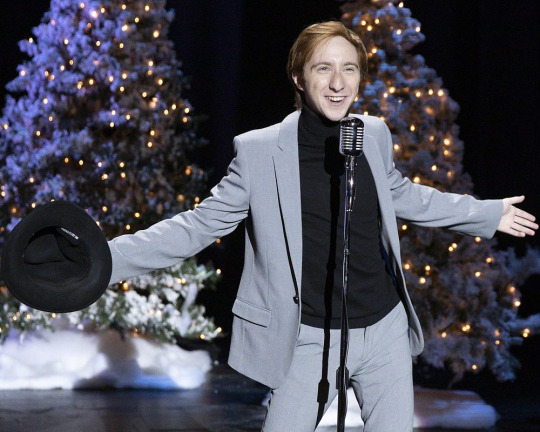
10. ‘White Christmas’ - performed by Larry Saperstein
With his background in theatre, there’s no surprise that Larry Saperstein (Big Red) is able to pull of a great performance. Throughout the number we see Saperstein setting up the stage and then donning a suit and tie as he takes on the Christmas classic.
The performance is sweet, and the vocals are nice, but it appears to lack much beyond that. Saying that, it’s not a bad performance overall, it just isn’t quite as good as the rest of the special, so for that reason, it’s our 10th best of the group.

9. ‘Little Saint Nick’ - performed by Joshua Bassett and Matt Cornett
The second Matt Cornett song of the special delivers a lot more than his solo. This duet with Joshua Bassett (Ricky Bowen) is a fresh and vibrant take on the Beach Boys classic, whilst not straying away from the boisterous vibes from the original.
The visuals also follow suit with the song, and whilst they’re not the most re-playable of clips, it’s still a fun and sweet performance attached to a vibrant song.

8. ‘This Christmas (Hang All the Mistletoe)’ - performed by Sofia Wylie
Kicking off the show we see Sofia Wylie take on Donny Hathaway’s song ‘This Christmas (Hang All the Mistletoe)’. Wylie is known as the show’s best dancer - by a mile - whilst also being a pretty decent singer, and this number is a great example of both of those.
The performance has its slight downfall with the vocals being slightly off at points, but when that happens, she makes up for it with her great dancing and camera presence.
A Sofia Wylie number would be expected to rank a little higher than her performance did here, but nonetheless her cover was still enjoyable. A more dance-focused visual may have been more beneficial for the young starlet, but this cover still does its job, and starts the special off to a wonderful beginning.

7. ‘Feliz Navidad’ - performed by Joe Serafini and Frankie Rodriguez
Out of the three duets of the special, this ranks highest as the chemistry, visuals and vocals carry this performance to better heights.
Joe Serafini (Seb Matthew-Smith) and Frankie Rodriguez (Carlos Rodriguez) are the show’s most underrated couple, as their characters lack the screen time of many others but still manage to make the most of it regardless. The same can be said here in this exciting cover of José Feliciano’s Christmas hit.
Much like Julia Lester, the two probably would have found a better result with a ballad, but unfortunately not everybody could be given that opportunity. Still, Serafini and Rodriguez knock it out the park with this amusing and cutesy cover, which is combined with adorable visuals of the two decorating a Christmas tree.

6. ‘That’s Christmas To Me’ - performed by Kate Reinders, Julia Lester, Frankie Rodriguez and Joe Serafini
In this thrilling Pentatonix cover we see four of the show’s best vocalists prove their place in this programme here. This cover features no instruments other than the vocals of the four performers, and it’s clear that they don’t need anything else.
Serafini is the standout of the group, but that isn’t to take away from the talent of the rest of them. The four vocalists create a perfectly spine-tingling cover that is both sweet and enticing.
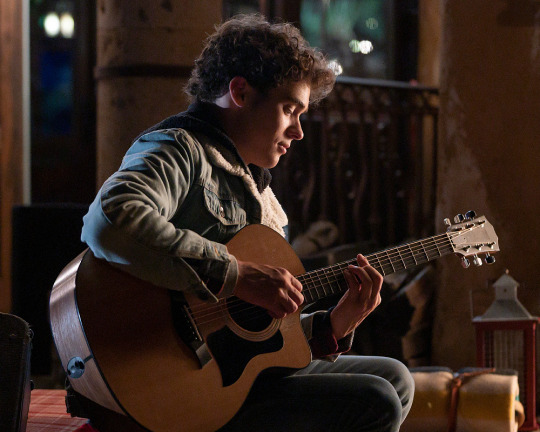
5. ‘The Perfect Gift’ - performed by Joshua Bassett
Another original song that also features on the show’s second season is Joshua Bassett’s ‘The Perfect Gift’, which he also wrote. This song is one of the standouts from the soundtrack, giving the romantic, coddling vibe that we’re so used to Ricky and Nini offering.
The lyrics of the song are sweet and warm, proving that ‘The Perfect Gift’ is a song that can easily become its own Christmas classic - and Bassett’s charming vocals make sure of it. This is a phenomenal song that one can imagine being serenaded with by the fireplace on a cold, Winter evening.
Its one letdown are the visuals, which could do with more ambitious B-roll, but other than that, ‘The Perfect Gift’ makes us even more exciting for the sophomore season.
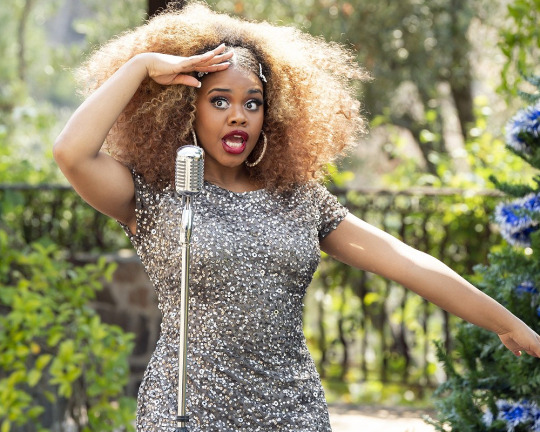
4. ‘Christmas (Baby Please Come Home)’ - performed by Dara Reneé
Vocally, this is the greatest song on the soundtrack. Dara Reneé (Kourtney Greene) hits every note and makes sure that the “replay” button is hit repeatedly.
Unfortunately, due to the fact that the visuals only feature two different shots and are combined with the closing credits, this performance isn’t placed as high as the song deserved.
'Christmas (Baby Please Come Home)’ has been covered by some of the greatest musical icons of all time, including Mariah Carey, Leona Lewis and Michael Bublé and - it appears that Reneé can find her place on that top 3 podium (sorry, Bublé).
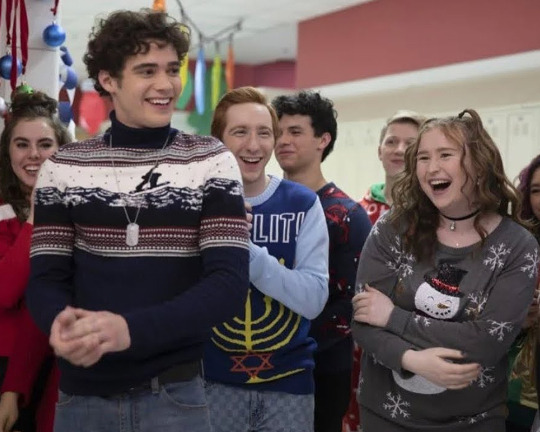
3. ‘Something In The Air’ - performed by the cast of ‘High School Musical: The Musical: The Series’
One of the two original songs from the special, ‘Something In The Air’ is actually a part of the second season; the Drama Club creates an Instagram page and uses this to attract more viewers to the page.
The song itself is very Disney Channel-esque (in a good way), giving very similar vibes to ‘Set It Off’ from ‘Descendants’. But what really brings the tune together are the ambitious “one-take” visuals. It definitely took more than one take, and each scene is also most definitely not filmed consecutively, but that doesn’t retract from how seamless each transition is and how much hard work went into perfecting each shot.
Sofia Wylie is the clear star of the performance with her breathtaking dancing, whilst everyone else delivers with their impeccable timing and impeccable energy.
The song is fun, but the visuals are even greater, making ‘Something In The Air’ one of the special’s best numbers.

2. ‘River’ - performed by Olivia Rodrigo
This Joni Mitchell song has been covered by Ellie Goulding, Lea Michele, and many more, and much like Reneé’s take on ‘Christmas (Baby Please Come Home)’, this deserves the same recognition as its predecessors.
Olivia Rodrigo (Nini Salazar-Roberts) can be given a piano and a microphone and create some of the greatest Disney musical magic we’ve seen, and her cover of ‘River’ is the epitome of that.
Her chilling vocals and solemn emotion gives this sad festive classic the mood it deserves, and makes us almost wish it were a part of the show’s canon with how sentimental Rodrigo makes it feel. This is a standout on the soundtrack, and definitely worth revisiting again and again.
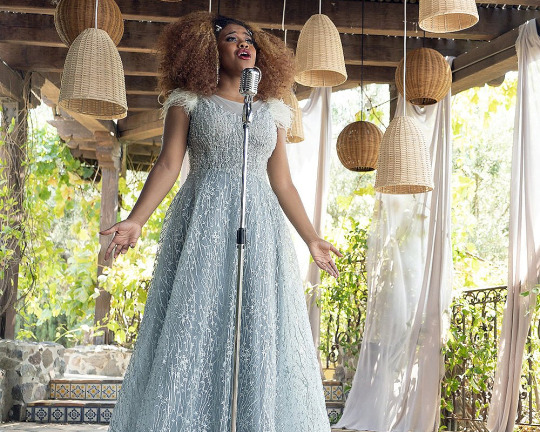
1. ‘Believe’ performed by Dara Reneé
If it were possible, we’d rename this show ‘The Dara Reneé Show’ as both of her performances take our breath away. Reneé’s cover of Josh Groban’s ‘The Polar Express’ song is the best song of the special. It is thrilling, emotive, and proves just how talented the young star is.
Reneé proved in the freshman season of ‘High School Musical: The Musical: The Series’ that she is one of (if not, the) best performer out of the cast, and if anyone were to ask you why you think that, ‘Believe’ would be your proof.
This stunning cover comes with so much charm and a fabulous set that it leaves no room for questioning why it is the best performance of the night.
What did you think of the special? Do you agree with these rankings? What performance was your favourite? Let us know!
‘High School Musical: The Musical: The Holiday Special’ is available to stream right now on Disney+!
#hsmtmts#high school musical: the musical: the series#high school musical: the musical: the holiday special#olivia rodrigo#dara renee#joshua bassett#joe serafini#frankie rodriguez#sofia wylie#matt cornett#julia lester#kate reinders#mark st cyr#larry saperstein#hsmtmts ranking#rankings#hsmtmts review#disney plus#hsmtmts holiday special#hsmtmts holiday special review
30 notes
·
View notes
Text
Ranking : Spike Lee (1957 - present)
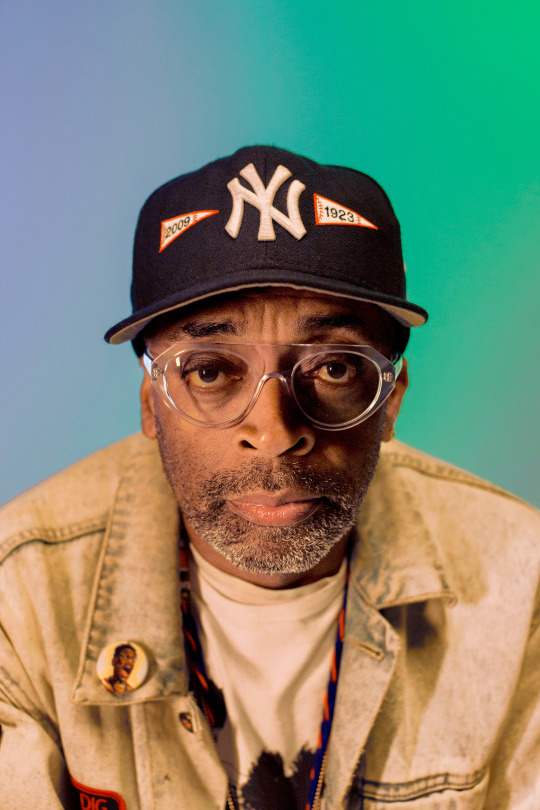
There have been countless directors whose careers have spanned my lifetime, but out of these countless masses, the one whom I can find the most in common ground with (as well as endless inspiration from) is Spike Lee. A New Yorker through and through, Lee went from a series of films that seamlessly blended hip-hop and old school Hollywood aesthetics, to personal films, to his take on the blockbuster, and currently, to the point where his canon has earned him artistic freedom and expression that many of his peers have not been able to achieve. He is the perfect bridge between the director-driven mindset of the 1970s and the cultural boundary-pushing films of the 1990s-forward. Not everything that he directed was a hit or a masterpiece, but this man has more iconic films under his belt that some directors have films to their name. That being said, it’s time to stir the pot and make an attempt at the monumental task that is ranking the films of Spike Lee.
I will only be including theatrically released feature films of Spike Lee that I have seen. His documentary work will be excluded, as well as his films I have missed or have yet to see. Here is a list of these films : Da 5 Bloods, Chi-Raq, Da Sweet Blood of Jesus, Joe’s Bed-Stuy Barbershop: We Cut Heads, 4 Little Girls, The Original Kings of Comedy, When the Levees Broke, A Huey P. Newton Story.
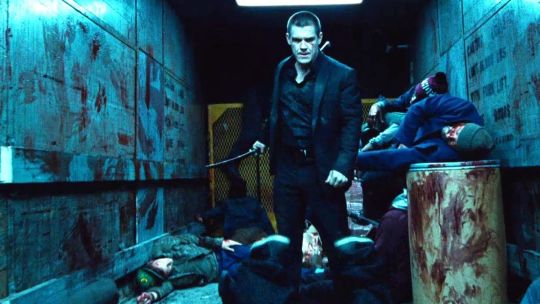
20. Oldboy (2013) Every film that you make can’t be a winner. In the case of Lee’s attempt at remaking Oldboy, there were already two major strikes against it : a superior version of the film already existed, and that version was the middle film of a trilogy. I doubt that even a team of the most talented directors could have made a superior version of Oldboy that surpassed the original, but after 30 years of making films, it’s admirable that Lee would even attempt something so bold and seemingly insurmountable.

19. Red Hook Summer (2012) When your film catalog covers three decades, there’s bound to be some overlap, be it stylistically or narratively. I’ve only seen Red Hook Summer once, but it was impossible for me to look at it subjectively, as it seemed to be a modern day mirror to another one of Lee’s explorations of New York adolescence. While this story is not a direct copy of a Spike Lee film that I will go into more detail on later, it does feel like the update equivalent that focuses on himself rather than the childhood of his sister. While an entertaining film from what I can remember, it sits behind a list of previous impressive achievements.
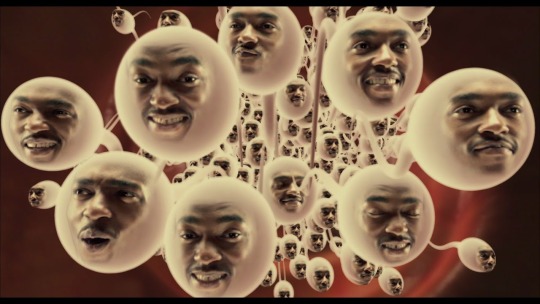
18. She Hate Me (2004) Humor has been an element present in a number of Spike Lee films, but for my money’s worth, this film is the closest thing to an outright comedy that he ever made. Like a number of films on the back half of his career, he is touching upon important topics (sexuality and toxic masculinity, in this case), but these are topics that he has hit with more nuance and creativity in earlier films. This film did help transition Anthony Mackie into a leading man role, and he certainly took that opportunity and ran with it, so She Hate Me could be heralded for that alone. That being said, it was a great idea that slightly missed the mark, therefore placing it on the backend of the memorable films list for Lee.

17. Miracle at St. Anna (2008) This film had the potential to be a breakout resurgence for Spike Lee. He was coming hot off the heels of Inside Man, a perfect blend of Lee’s style and modern Hollywood fare, so having a period-piece war film seemed like a slam dunk. His cast was strong, while also being filled of relatively unknown young actors on the verge of becoming stars in their own right, but for whatever reason, this film failed to make a connection with the masses. While I do remember mostly enjoying my watch, I also remember feeling a bit underwhelmed by the ending, which in turn left me lacking a reason to revisit it. Maybe it’s a hidden gem that I haven’t seen enough times yet, but at this moment in time, its home is near the bottom of Lee’s impressive list of films.
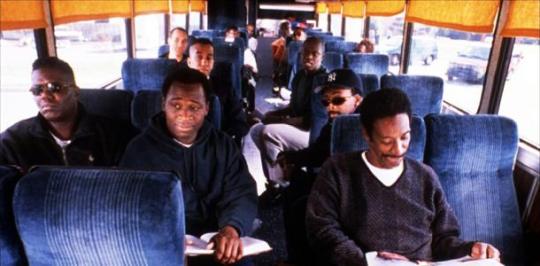
16. Get on the Bus (1996) Many people’s eyes were opened to racial injustices during the COVID-19 pandemic, as several African-American men and women found themselves on the wrong end of violent acts from the police and other citizens in the midst of a ‘shelter-in-place’ era. Not only have these injustices been going on for my entire lifetime, but they’ve been a generational trauma for many African-Americans in the United States. When the Million Man March was announced in 1996, it was not surprising that Spike Lee took it as an opportunity to both document the march and build a narrative around it in which he could showcase a collection of actors he’d either featured in past films or would work with in future films. To my knowledge, this is one of maybe two or three films about the event, and it was certainly the film released in the closest proximity to it. For an independent, quick shoot, it definitely stands up, but in comparison to Lee’s other works that benefited from full crews and production schedules, it finds itself paling in comparison.

15. BlacKkKlansman (2018) Despite the fact that this is the film that finally got Lee some sort of recognition at the Oscars, BlacKkKlansman was not quite the true return to form that many fans of Spike Lee expected. The film had moments of humor, compelling moments that directly focused on racial injustice and systematic oppression, and it pulled no punches while doing so. Like a handful of Lee’s other films, however, this one falls when compared to his other films that deal with similar subject matter. Adam Driver continued to show fans his expansive range, and Jasper Paakonen deserved INFINITELY more recognition than he got, but ultimately, this film checks all the ‘good’ boxes where it was expected to check the ‘great’ ones.
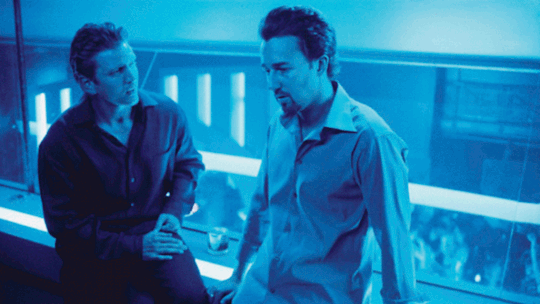
14. 25th Hour (2002) As the year 2000 approached, Lee seemed to attempt and make a shift from films that specifically spoke on aspects of the African-American experience in favor of occasional films that reached a wider audience. While Summer of Sam would be considered the first foray into that realm, the true mark of this elevated sense of creative duty came in the form of 25th Hour. With the actors in tow, in tandem with the cinematography and skilled directing ability displayed in the film, one would expect a powerhouse movie, but ultimately, the expectations exceeded the narrative of this film. This one is entertaining, don’t get me wrong, but I personally did not find a connection with the story, meaning that the film was, at best, fun to watch.
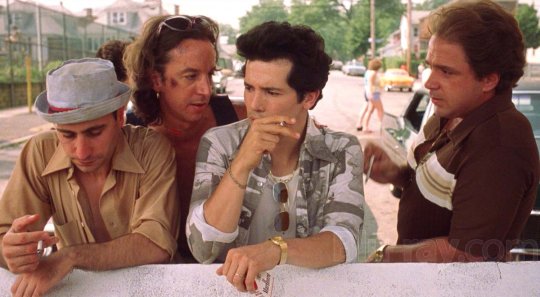
13. Summer of Sam (1999) I’ve been a true-crime junkie since my early teenage years, and even the most casual of true-crime fans is more than likely familiar with David Berkowitz, also known to many as the Son of Sam. While Red Hook Summer did come out after Summer of Sam, it’d be hard to deny the fact that Summer of Sam is the last of Lee’s love letters to New York City. This was the film where Spike Lee stepped out of his comfort zone of the African-American experience, choosing instead to focus on more colloquial aspects of the American experience, and for my money’s worth, it was the start of an important shift for him. Despite being light on the Son of Sam action, the actors this film does focus on (and the story it chooses to tell) is a fresh look at a familiar era, and a crowning achievement that signaled new things for Spike Lee.
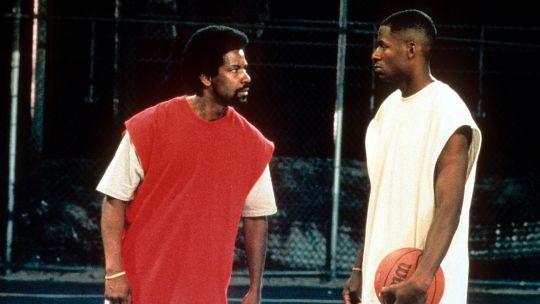
12. He Got Game (1998) If you made a Venn diagram of people familiar with Spike Lee, the two biggest circles would be film fans and people who have seen at least one New York Knicks game since the 1990s. Therefore, the only thing that was really and truly surprising about He Got Game was the fact that it took Spike Lee 15 years and 11 films to make a film about basketball. On the outset, that’s exactly what it is : a film about basketball. Viewed with a wider lens, however, this story is a love letter to one of the most popular American inventions, and a story about how it can serve as a common-ground bridge for those from wholly different walks of life. The juxtaposition of Aaron Copland and Public Enemy made the soundtrack provocative, and Ray Allen stood out in his lead role, holding his own against the living legend that is Denzel Washington, who is always good for a stellar performance in a Spike Lee joint. Don’t mistake this film’s place on the list for my feelings about it... this is a stellar film, in my opinion, and one of my favorites to revisit.

11. Crooklyn (1994) After making what many would argue to be the most important film of his career (which we will eventually get to), it’s no surprise that Spike Lee circled his creative wagons and made the focus of his next film inward. Crooklyn covers what seem like many personal bases for Spike Lee : he portrays the New York of the past vividly and beautifully, while spinning a true-to-life tale based on his personal experience, but opting to focus on his sister Joie Lee and his father Bill Lee. Of Lee’s many, many films, this was the one that I felt the most compelled to see at the time of release, it is one of the two I have the most vivid memories and recollections of, and it has a number of stylistic choices that keep me wonderfully perplexed to this day. Despite not cracking the top ten Spike Lee films, this one ranks high on the list of Spike Lee films that hit the bullseye of my heart.

10. Jungle Fever (1991) Interracial romance is one of those things that seemingly will always be a sensitive subject. I’ve heard many people say that Jungle Fever has a dated look on the subject, but I’d argue that the film was very forward thinking, especially in showing that an interracial romance is not the answer to the cultural and societal problems that life presents us. The movie also touches deeply on drug addiction without crossing over into the realm of being preachy or talking down to the viewer. It didn’t hurt that Stevie Wonder also managed to create a soundtrack’s worth of new material that instantly brought the seemingly controversial film directly into the public eye. Maybe it is dated... maybe it is uncomfortable... but what it is, undoubtedly, is an early masterpiece that fell near the end of one of the most stellar introductory runs that any filmmaker has presented us.
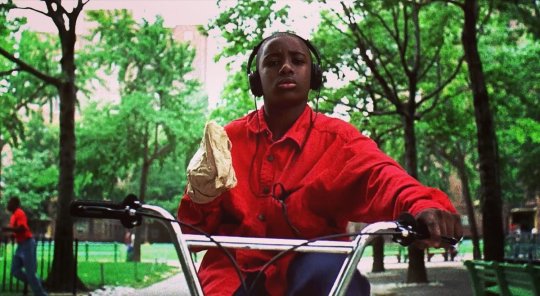
9. Clockers (1995) Ever wonder what would happen if a Martin Scorsese film found its way into the hands of Spike Lee? Well, wonder no longer, because Clockers is out there waiting for you to discover it. The amount that this movie gets slept on is an outright tragedy and travesty. The soundtrack is KILLER, the color-timing puts the viewer in an immediate ‘cold-world’ environment, the order of operations presented in this film is brutal and unforgiving, and yet, it manages to be one of the most heartfelt films in the Spike Lee canon. EVERYONE presented in this movie brought their A-game to the table, from the Spike Lee regulars like Isaiah Washington, John Turturro and Harvey Keitel, to the glorified cameos and supporting roles, like Thomas Jefferson Byrd, Sticky Fingaz and Fredro of Onyx, and relative newcomer but promising leading man Makhi Phifer. This film is intense, but it is more than worth your time and attention.
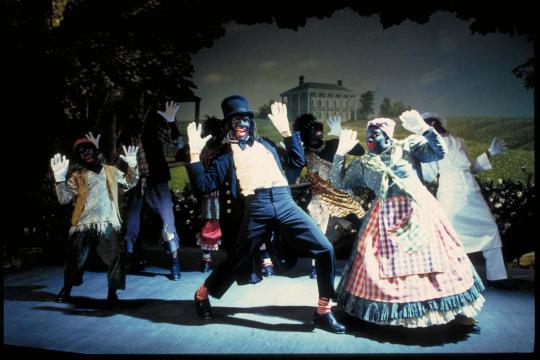
8. Bamboozled (2000) Bamboozled was shocking when it was released, to say the least. The true revelation, however, has been the way that relevance has seemingly caught up to the film... fake wokeness, modern day minstrel shows, low budget/high yield television and behind the scenes scandals have all come to light many years after this film had its initial run. While this film did not transition Savion Glover into the world of superstardom and crossover success, it certainly crystalized his immense talent and charisma in a way that his recordings of stage shows had previously been unable to capture. The imagery of America’s strange fascination with the dehumanization of African-Americans for generation after generation is rich, and every performance is compelling. This was definitely Spike Lee’s first masterpiece of the new millennium, and at the risk of being bittersweet, probably one of his last truly stunning achievements.

7. Girl 6 (1996) Every ranking list has to have the controversial placement, so here’s mine... Girl 6 started as a lingering interest for me. The internet was just about to change the world, but we were still locked into landlines at the time, with cellular being a luxury, so the world of phone sex still had relevance. Upon seeing the film, however, I quickly realized that the phone sex exploration was playing counter to a Hollywood hopeful narrative that was brave enough to explore new ground (per the changing times) while being mindful enough to pay homage to the countless stories of Hollywood hopefuls that came before it. Many of the shifting cinematography looks that made Clockers so gritty were used to make Girl 6 feel dangerously euphoric. The list of cameos and brief supporting roles were not only a who’s who of cultural movers and shakers at the time, but it ran about as long as my arm. I recently revisited the film and expected it to be a bit more on the side of kitsch, but surprisingly, the times had not been as hard on the film as I anticipated. The film shifts quite well between light and dark, and even the ending that initially slightly annoyed me has found a strange sort of charm in my older, more life-experienced years. Add to this the hilarious running joke of Isaiah Washington being a kleptomaniac in nearly every scene he appears in, and there’s a realization that there are sublayers going on right in front of our eyes. This collaboration with Suzan-Lori Parks gives me hope that maybe one day, we’ll get a Spike Lee film adaptation of Topdog/Underdog, but we will see.
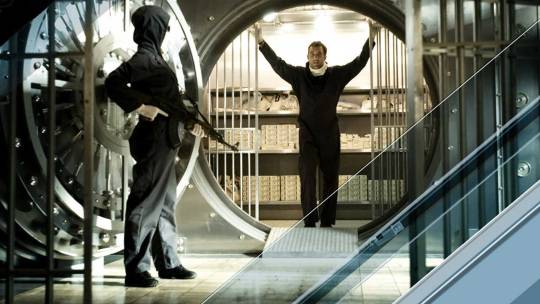
6. Inside Man (2006) If you had to pick the most ‘Hollywood’ of the Spike Lee films, my money would be on this film ending up as the chosen one. By this rationale, it makes the film that much more impressive, as it also stands out as one of the most compelling, well-directed and well-acted Spike Lee films. At the time of its release, it was not only a return to form, but it seemed to signal an evolution. Spike Lee was able to use his signature, iconic shots that he was known for, like his camera-turned-to-dolly float, or the push-pull zooms, but he was also able to incorporate familiar Hollywood tropes, including the twist ending, and give them a breath of fresh air via an newly infused sense of style. Lee also stayed true to himself by educating as well as entertaining, bringing to light how atrocities from the past have more than historical connections to modern day benefactors. While I do think there are a handful of better ‘pure’ Spike Lee films, if I had to pick one movie for a curious party that my be skeptical, this would easily be my pick.

5. She's Gotta Have It (1986) Oh, the joy of having your first film be a breakout success, but not to the point of pigeon-holing your career. She’s Gotta Have It was an important introductory step to the masses for Spike Lee : it showed his dedication to putting African-American performers into familiar narratives, it showed an appreciation for the voice of women on film that many first-time directors would likely not want to be the initial association to their style, it introduced the world to Mars Blackmon (who became a cultural icon), and it presented sense of style that switched on the viewer the moment before they could label it pretentious. Having characters address the camera made it feel like a play or a novel, but when the film shifted into movie mode, the camera moved with the energy and grace of a performance artist or dancer, which in turn fed into the character development and narrative it presented. As a bonus, the property found new life nearly 40 years later as a Netflix original series, introducing new generations to a modern day classic statement of feminism, and how it does not excuse bad behavior.

4. Mo' Better Blues (1990) Those familiar with Spike Lee’s family know that he was raised by jazz bassist Bill Lee, who scored some of Spike’s early films. By this rationale, it comes as no surprise that Lee could make such a rich, nuanced and heartfelt film about jazz music that serves as an allegory for the hurdles that beset those driven purely by passion. The conversations about race, musical integrity and commercialism also work on both direct and symbolic levels, giving Mo’ Better Blues some of the highest repeat viewing value of any film in the Spike Lee canon. The film also marked the first collaboration of Spike Lee and Denzel Washington, a combination that yielded artistic, career, creative, commercial and critical success, led to a multitude of classic performances, and ultimately led to a generational collaborative changing of the guard in the form of John David Washington. The only negative I can give this film is that it did not lead to future films that explored genres of music like hip-hop and soul. While She’s Gotta Have It did focus heavily on relationships and intimacy, it could be argued that Mo’ Better Blues was Spike Lee’s first adult contemporary film, and his first look at modern romance in the more ‘traditional’ sense.
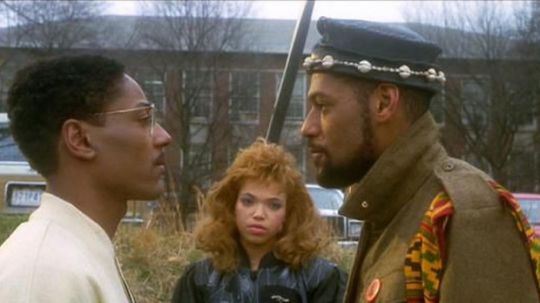
3. School Daze (1988) The African-American college experience, specifically that of HBCUs (Historically Black College and Universitys), is one that has often been neglected in the annals of film history. As a graduate of Clark Atlanta University, it makes total sense that Spike Lee’s second commercial film would focus on that specifically overlooked culture, as it became a fitting vehicle for establishing Lee’s sense of duty and responsibility for education, sharing the African-American experience to the masses, and exposing systematic injustices and hypocrisies that kep the disadvantaged in a disadvantaged position. The real genius of this film, however, comes in the juxtaposition of presentations it jumps between... for the majority of the film, it is an unflinching look at the coming of age process that teenagers must traverse on their way to adulthood, including the hurdles of romance, forming your identity and expanding your view of the world around you. At key moments, however, the film switches into musical numbers, song performances and school dances that not only expand on the inner feelings, emotions and desires of characters, but heighten the reality of the story to a dizzying pace. In all the ways that She’s Gotta Have It put the world on notice that a unique voice was present in the industry, School Daze signaled the continuation of a run that would last another handful of films, and it firmly established Spike Lee as a generational talent.
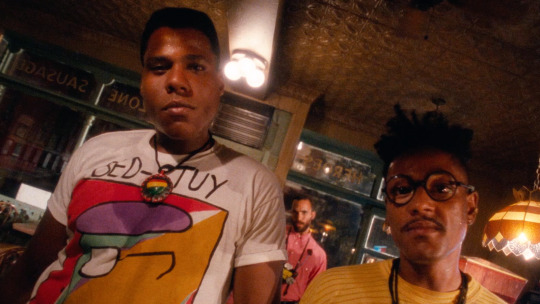
2. Do the Right Thing (1989) I would guess that over the course of a career, a director secretly hopes that at least one of their works comes close to making an impact culturally. In the case of Spike Lee, however, we have a man who released two cultural-shifting films, and did so in a span of less than 5 years. They say the third time is a charm, and that’s exactly what Do the Right Thing was for Spike Lee. The vivid colors, stylistic earmarks, historical and cultural sense of urgency and focus on telling minority stories all expanded greatly with this film, which acted as both a parable of how past injustices can come back to haunt you, and a harbinger of how the reactions to these continued injustices would only amplify if not addressed. The fact that Spike Lee not only directed this film, but played the lead actor as well, is a monumental achievement, especially considering how few flaws the film has, if any. Several established actors played some of their most iconic roles in this film, and a breadth of newer, younger faces exploded onto the scene, almost all of whom either continued to work with Lee or found themselves evolving their careers in the wake of Do the Right Thing. The film is also directly responsible for perhaps the most iconic hip-hop song of all time, Public Enemy’s classic protest anthem Fight The Power. Any fan of film would be foolish to skip the Spike Lee catalog, but regardless of whether you’re interested in his work or not, this film is one of two he made that should flatly be considered required viewing across the board. The other one, being...
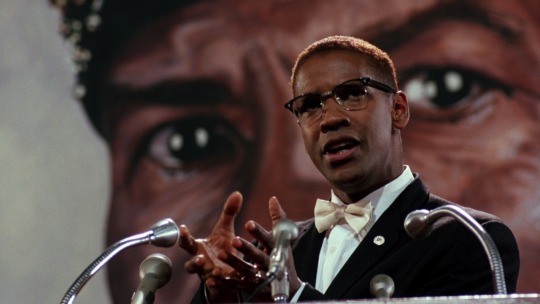
1. Malcolm X (1992) For everything that Do the Right Thing did for Spike Lee and those involved in the production, the monumentally powerful biopic Malcolm X did all of that while also managing to humanize, canonize and create and icon out of a man that America tried its best to demonize. The masterful hand that Lee used to direct this film shows, as this film is the most ‘every frame a painting’ in his canon. Everything from the period costuming to the locations to the dance numbers to the cinematography absolutely leaps off of the screen. The editing is kinetic, the performances are full of life and depth, and the narrative does just enough going forwards and backwards to make proper connections without beating it over the head of the viewer. The respect shown to Malcolm X is massive, so much so that almost seemingly overnight, Malcolm X went from being a feared and often heavily criticized sign of aggressive blackness to a commercial commodity and household name, with the famous X suddenly adorning t-shirts, baseball caps and necklaces of all American youth, not just minorities. The impact of this film was so immediate that many schools held field trips for viewings, which further cemented the immediate and historical value of the film. Often, the connotation of saying someone ‘peaked’ for a film so early in their career would be negative, but the heights to which Malcolm X achieved on all fronts meant that even if the rest of Lee’s career was a steady decline (which it certainly wasn’t), he more than likely still would have ended up in a pantheon far above that of the average director.
With projects reportedly in the early stages of development, it doesn’t look like Spike Lee has any plans on stopping anytime soon. I certainly owe it to myself to see the handful of his films and documentaries that I’ve not seen yet... who knows, perhaps I may even go back one day and add the documentaries into the list, or find a surprise gem in one of his more recent movies I’ve yet to see.
#ChiefDoomsday#DOOMonFILM#SpikeLee#JoesBedStuyBarbershopWeCutHeads#ShesGottaHaveIt#SchoolDaze#DoTheRightThing#MoBetterBlues#JungleFever#MalcolmX#Crooklyn#Clockers#Girl6#GetOnTheBus#HeGotGame#SummerOfSam#Bamboozled#25thHour#SheHateMe#InsideMan#MiracleAtStAnna#RedHookSummer#Oldboy#DaSweetBloodofJesus#ChiRaq#Blackkklansman#Da5Bloods
18 notes
·
View notes
Text
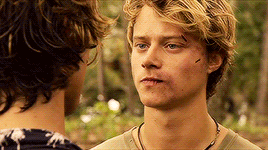
RUDY PANKOW , 22 , HE/HIM/HIS , CIS MAN | hey is that MONROE ST. THOMAS ? i think i’ve seen the 23 year old walking around THE CUT , so i guess that means they’re a POGUE ? apparently if the weather’s right, you can find them SNEAKING A JOINT INSTEAD OF A CIGARETTE BREAK , which makes sense since they’ve got the whole SCARS THAT WILL TELL STORIES IF YOU LET THEM, A SMILE THAT IS BROKEN BUT STILL BEAUTIFUL & A CANVAS SPLASHED IN THE SAME COLOR AS BRUISES thing about them . if people had background music , their song would definitely be CROWDED PLACES BY BANKS
monroe is very much the definition of what you expect to find when you come into the cut. that being said, there are different layers to him, some that are more hidden than the others. on one hand, he’s the boy who was a proud all star for the highschool football team, the all american version of what the dream is supposed to look like. on the other, he’s the same one who couldn’t afford to get himself to the away games, or the guy that can quote you poetry from memory, when he gets just high enough, each person usually gets a piece of him, a version, but never the full fledged experience, because he knows just what it is like to be “too much”, therapy has told him that, for better or for worse.
while plenty of people seem to think that his stint in rehab, something that he does not bother to hide from most of the general public, would have taught him not to drink or smoke, that is hardly the case. he instead learned that he can’t always use them as coping mechanisms, which means that he’s had to learn other avenues to get out the weight of his emotions, one of which happens to be art, you know, when he’s not busy crying in the privacy of the shower like the rest of us.
due to what happened in the car crash with his mother and sister, he has a plethora of scars sprinkled across his shoulders. while that doesn’t stop him from spending a good portion of time shirtless when the weather permits, the people that actually ask about them are usually met with avoidance, and sometimes even aggression. there are some things he will never really know how to talk about, no matter how long it’s been since he woke up in that hospital bed. speaking of scars, monroe is also painfully aware of the ones that came from his brothers experience coming out, and part of that, forces him to be very open about his own sexuality, or rather, blunt about the interest in people regardless of their genitals (and you can fight him about it, too, these hands are free ninety nine, always)
WC1: the exception to the rule, is the name of the game here. this is someone who despite monroe’s usual tendency to never really show his hand, sees through his bullshit, and actually knows him. however far that relationship goes, or will do, is definitely up to us and we can see where it leads, chemistry wise, but this is someone who is unbelievably special to him. he usually doesn’t admit it easily, or in the usual ways, and probably still tries to avoid them when they get a little too close, but usually ends up running right back in less than 24 hours. they even seem to have learned to understand that, or at least accept it, but feel free to torture him a little bit after he tries to run.
the middle children are the ones that are born with tragedy in their bones. They always said that Monroe absorbed all his sisters hurt in the womb, his very first act somehow becoming one of protection. To him, the statement now rang with bittersweet irony, but that’s the story’s tendency to get ahead of itself. In the beginning they were the perfect picture of the American dream, the one that was bought and sold, embraced with open arms. Sure, the floors in the old beach house were always dirty, and his father worked longer than he ever should have had to in order to keep their plates full, but they made it. Caroline started working again after the kids had all started school, breathing a sigh of relief with Kase finally passed that milestone birthday that would allowed her to begin taking the steps to contribute.
by then, his older brother had already begun taking on the family’s burdens, a nervous habit that had long since been coined as the family curse. He knew now that it was guilt that drove him to take that step, a strange since of misplaced shamed in the secret he was about to reveal to them all. The night that the words left his lips, they all remember it differently. It was a confessional that should have been met with love and support, but the scar that the two eldest boys were left with was one that had no chance at healing. The only part of the memory that seemed intent on sticking around was the sound of skin meeting skin in a vicious chorus, and the darkening bruises mixed with blood that formed as a direct result of the backhand that would eventually become the soundtrack to their demise.
that’s right, his brother came out to his family, and David’s first reaction was to take his feelings out on Smith physically, in front of the entire family. It didn’t matter if the bible had fanned the flames of his intolerance, or taught him some misplaced wrong rooted in sexuality, what did matter? Caroline wasn’t going to stand for it. Two weeks later, David left without a word, or a single cent, in his wake. The abandonment of his family seemed easy, and they never received the decency of an apology or even the watchful eye of shame. Nothing, not a single word, and his name became a welcomed taboo in the story, dad was the dirtiest curse word to ever leave any of their lips.
monroe didn’t talk about the nightmares that plagued him in the weeks after, but Smith always seemed to be awake right in time to shake him out of them. The silent agreement to keep secrets between siblings, a small bond that eventually cemented the lines of love between the two. It was no surprise to anyone that he followed in the footsteps of Smith, soon confessing his own struggles, but for him? There were welcome arms, acceptance was offered in free fall, because he needed it, and maybe it was that helped them all heal from the things that they still didn’t know how to speak of. What it didn’t do, was fill the gap that was created by their fathers (if you could even call him that) absence. Eventually, all five of them learned what it was like to be hungry, all the things that Caroline had desperately been trying to keep them away from. Some lessons weren’t meant to be learned, she’d say.
smith graduated high school the same year, a full ride scholarship he could never take, meaning that Monroe was the next to fall victim to the aforementioned curse that came with crushing weight on the shoulders of every member, but especially him. Life seemed to have a fucked up way of changing lanes, though. Caroline was running late, in the rain, to one of her many jobs. It was an unfortunate side effect of her newly minted single motherhood, after all. Dallas was in the car, to be dropped off at the baby sitter, but they would never make it there. The skidding sound of wet tires on warm asphalt, the high pitched screams of metal twisting metal, it all added another track added to the symphony of this tragedy.
you’re so lucky. It’s a miracle. The statements are repeated over and over, like a broken record, but they turn his stomach every time. A miracle, any God, would have either sent him away with his sister, the one he had been born trying to protect, and his mother, who would have died for him time and time again. The first time he told this to a therapist, the change in their expression announced what would be his first forced commitment, something that no one expected, and it tore all his buried scars wide open. Maybe that’s why they say rehab always feels like you’re bleeding out.
two months later, the only thing he was permitted out for was the funeral. His brothers came to visit three times a week, and often, they would cling to each other like the the last straws left in what felt like a burning building. After month three, he was released with false promises of therapy, with fake smiles that said he would take care of it, and the only reason he did seek out a way to cope was to honor the memory of his mother. he finally learned that he wasn’t an addict, but he needed to learn the secret of moderation. he needed to learn a lot of things, and now was going to be the start of that, including how to be a little more unapologetically himself.
3 notes
·
View notes